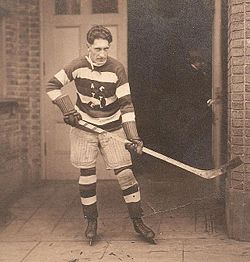

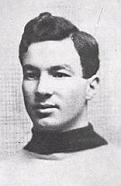


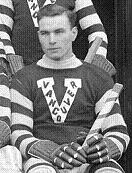


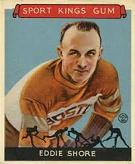
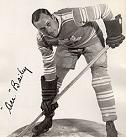

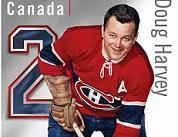

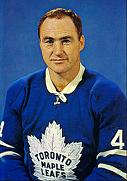

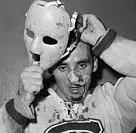
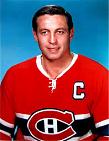



















TLW's Hockey Historyscope |
By T.L. Winslow (TLW), the Historyscoper™ |
© Copyright by T.L. Winslow. All Rights Reserved. |
Original Pub. Date: July 1, 2012. Last Update: Feb. 26, 2020. |
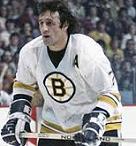



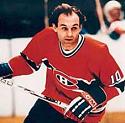


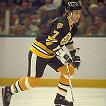



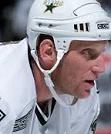



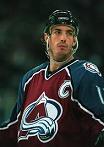


"The fastest sport on ice" Ice Hockey is very duh, white Canadian, taking frozen lakes and rough types who like to ice skate and have high pain thresholds such as lumberjacks, usually of French or Scandinavian descent. Like other pro sports, top performance might have a genetic component, because African men have too narrow hips and too much fast-twitch muscle for this sport that favors wide hips and slow-twitch muscles? It helps to know that until the introduction of fortified milk, blacks couldn't make enough Vitamin D via sunshine to maintain their health, and got rickets?
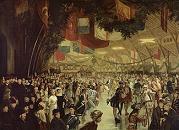
In 1862 the Victoria Skating Rink in Montreal, Quebec, Canada opens, becoming the site of the first-ever ice hockey game on Mar. 3, 1875, and the first Stanley Cup playoff games in 1894; in 1889 Lord Frederick Stanley witnesses his first ice hockey game there; after it becomes the first bldg. in Canada to be electrified, in 1896 telegraph wires are connected to broadcast live to fans in Winnipeg; it also helps the development of figure skating in Canada.

On Mar. 3, 1875 the first indoor ice hockey game is played at the Victoria Skating Rink in Montreal, Quebec, Canada (opened in 1862), organized by James George Aylwin Creighton (1850-1930), who captains the team that wins over the one led by Charles Torrance 2-1, causing ice hockey to begin catching on in Canada; on Feb. 27, 1877 he pub. the first rules for ice hockey in The Gazette, which are virtually identical to those for field hockey; the ice surface dims. of the Victoria Skating Rink are made the std.; originally ice hockey is played with seven players on each side, incl. the goaltender, two defencemen, three forwards, and the rover, who roams the ice at will; the rover is dropped by the Nat. Hockey Assoc. in 1910 and the Nat. Hockey League in 1917, but kept by the Pacific Coast Hockey Assoc. in 1911, and the Western Canada Hockey League in 1921; the first Olympic ice hockey tournament in 1920 uses a rover, after which it is elminated; in 1923 the PCHA and WCHL also eliminate it.

In 1877 the Montreal Hockey Club in Quebec (known for its winged wheel logo) is founded, formally organizing on Nov. 28, 1884 as a member of the Montreal Amateur Athletic Assoc. (MAA) , playing its first game on Jan. 20, 1885 against the McGill U. team, winning 2-1, co-founding the Amateur Hockey Assoc. of Canada (AHAC) (1886) before joining the Canadian Amateur Hockey League (1898), Eastern Canada Amateur Hockey Assoc. (ECAHA) (1905), and Inter-Provincial Amateur Hockey Union (1908); the 1930 team wins the Allan Cup; the 1902 team becomes known as the Little Men of Iron, who form the core of the Montreal Wanderers.
In June 1881 the Montreal Amateur Athletic Assoc. (MAAA) is founded in Quebec, Canada by the Montreal Snow Shoe club, the Montreal Bicycle Club, and the Montreal Lacross Club, holding games in Montreal Gymnasium.
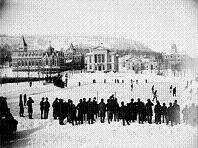
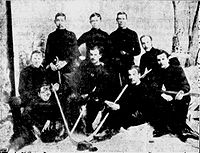
In 1883 the first Montreal Winter Carnival Ice Hockey Tournament, organized by the Montreal Amateur Athletic Assoc. (MAAA) is held, featuring an ice castle or fort that can be stormed in mock attacks, along with snowshoe races, toboggan slides, skating carnivals, and the first ice hockey championships, with four teams incl. the McGill U. Club, the Montreal Hockey Club, Montreal Crystals, and Montreal Victorias); the first tournament is held on the St. Lawrence River, the 2nd at the outdoor rink of McGill U.; after cancelling in 1886 and 1888, the last tournament is held in 1889; in 1883 1 mo. after witnessing the 1883 Montreal Winter Carnival, the Ottawa Senators (originally the Ottawa Hockey Club or Ottawa HC) ice hockey club is founded in Ottawa, Ont., becoming their first ice hockey club, becoming the Ottawa Generals in the 1890s, the Ottawa Silver Seven in 1903, and the Ottawa Senators in 1908; they disband in 1934.
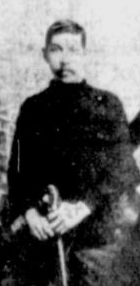
On Dec. 8, 1886 the Amateur Hockey Assoc. of Canada (AHAC) is founded in Montreal, Quebec, becoming the 2nd Canadian hockey league after one founded in 1883 in Kingston, Ont.; teams incl. the Montreal Victorias, Montreal Crystals, Montreal Hockey Club, Ottawa Hockey Club, and McGill U. Club; pres. #1 is Canadian Mohawk Ottawa Senators captain (1886-7) Thomas Daniel Green (1857-1935); it disbands in 1898; each team has six players, incl. left wing, right wing, centre, rover, point, and coverpoint; first team to score a goal wins the game.
On Jan. 6-Mar. 11, 1887 the first 1887 Amateur Hockey Assoc. of Canada (AHAC) Season sees the Montreal Crystals win with a 6-1 record.
On Jan. 13-Mar. 12, 1888 the 1888 Amateur Hockey Assoc. of Canada (AHAC) Season sees the Montreal Hockey Club and Montreal Victorias 2-1 tie with 5-1 records, after which on Mar. 15 the Montreal Hockey Club defeats them 2-1 to win the title.
On Dec. 15, 1888-Mar. 27, 1889 the 1888-89 Amateur Hockey Assoc. of Canada (AHAC) Season sees the Montreal Hockey Club win with a 6-1 record, becoming their 2nd straight title.
On Jan. 3-Mar. 4, 1890 the 1890 Amateur Hockey Assoc. of Canada (AHAC) Season sees the Montreal Hockey Club win with a 7-0 record, becoming their 3rd straight title.

On Nov. 27, 1890 after a suggestion by Arthur Stanley, son of Canadian gov.-gen Lord Stanley, the Ontario Hockey Assoc, is founded to govern amateur play in Ontario, with teams incl. the Ottawa Hockey Club, Queen's U. of Kingston, the Toronto Marlboros, and the Toronto Wellingtontons; in 1891 it establishes the Cosby Cup, which is won in 1891-3 by the Ottawa Hockey Club, which leaves the league in 1894; it is last awarded in 1899.
On Jan. 7-Mar. 5, 1891 the 1891 Amateur Hockey Assoc. of Canada (AHAC) Season sees the Montreal Hockey Club win 8-0.
On Jan. 8-Mar. 7, 1892 the 1892 Amateur Hockey Assoc. of Canada (AHAC) Season sees the Ottawa Hockey Club defeat the Montreal Hockey Club 4-3 on Jan. 8 then lose it 1-0 to them on Mar. 7.


On Jan. 7-Mar. 7, 1893 the 1893 Amateur Hockey Assoc. of Canada (AHAC) Season (games alternate between rover and non-rover versions) sees the Montreal Hockey Club win for the 6th straight time, becoming the first winner of the Stanley Cup (La Coupe Stanley) (originally the Dominion Hockey Challenge Cup) on May 15, donated last year by Frederick Arthur, Lord Stanley of Preston (16th Earl of Derby) (1841-1908) (gov.-gen. of Canada in 1888-93), who returns to England during the 1893 season and never watches a championship game or sees his trophy.
On Jan. 5-Mar. 10, 1894 the 1894 Amateur Hockey Assoc. of Canada (AHAC) Season sees the Montreal Hockey Club and Ottawa Hockey Club tie 5-3, after which the Stanley Cup playoff game on Mar. 17 sees the Montreal Hockey Club win by 3-2, defending their title on Mar. 22 with a 3-1 win over the Ottawa Hockey Club.
In 1894 the Edmonton Hockey Club in Canada is founded, consisting of the elite Thistles and junior Stars, made up mostly of Scottish players; after the Thistles play a series against the Mounties from Ft. Saskatchewan in 1895, the Stars first play the South Edmonton Shamrocks on Jan. 1896, and the Thistles first play the Shamrocks on Jan. 31, 1896, they are officially organized on Nov. 20, 1896; at first playing games on the North Saskatechewan River, they soon move into the Thistle Rink (cap. 2K), which burns down in 1912; they fold in 1910.
In 1894 the North Avenue Ice Palace in Baltimore, Md. opens, becoming the first ice rink in North Am. utilizing a mechanically-frozen ice surface.
In the winter of 1894-5 a group of U.S. college students visit Canada and bring the game of hockey to the U.S.
On Jan. 3-Mar. 8, 1895 the 1895 Amateur Hockey Assoc. of Canada (AHAC) Season sees the Montreal Victorias win with a 6-2 record, winning the Stanley Cup after the Montreal Hockey Club defeats Queen's U. 5-1 on Mar. 9.
On Jan. 3-Mar. 7, 1896 the 1896 Amateur Hockey Assoc. of Canada (AHAC) Season sees the Montreal Victorias with with a 7-1 record; on Feb. 14 the Winnipeg Victorias of the Manitoba Hockey Assoc. (MHA) defeat the Montreal Victorias 2-0 to win the Stanley Cup, becoming the first non-AHAC team; on Dec. 30 the Montreal Victorias defeat the Winnipeg Victorias 6-5 to win the Stanley Cup back.
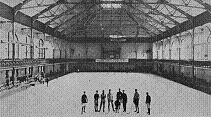
On Nov. 7, 1896 St. Nicholas Rink AKA The Rink at the NE corner of 66th St. and Columbus Ave. in Manhattan, N.Y. opens as the home of the St. Nicholas Hockey Club of the Am. Amateur Hockey League (AAHL), designed by Flagg and Chambers and built by Cornelius Vanderbilt and John Jacob Astor, becoming the 2nd ice rink in North Am. with a mechanically-frozen ice surface; on Feb. 26, 1900 it hosts the first ice hockey game between Harvard U. and Yale U., with Yale winning by 5-4; in 1906 it is converted to boxing, becoming a popular arena for prize fighting after it is legalized in 1911; in 1917 it hosts the first women's ice hockey game in the U.S., with the St. Nicholas team defeating Boston 1-0; the men's team switches to the Eastern Amateur Hockey League (EAHL) and moves to Madison Square Garden; on Aug. 6, 1956 the DuMont Network airs its last show "Boxing from St. Nicholas Arena"; on May 19, 1962 Cassius Clay KOs Billy Daniels in round 7; it closes after the last boxing match on May 28, 1962, becoming a production center for ABC-TV and local station WABC-TV and home of "Eyewitness News"; the bldg. is demolished in the 1980s.
On Jan. 9-Mar. 6, 1897 the 1897 Amateur Hockey Assoc. of Canada (AHAC) Season sees the Montreal Victorias win with a 7-1 record.
On Jan. 4-Mar. 5, 1898 the 1898 Amateur Hockey Assoc. of Canada (AHAC) Season sees the Montreal Victorias win with an 8-9, retaining the Stanley Cup .
On Dec. 14, 1898 after a Dec. 10 Amateur Hockey Assoc. of Canada (AHAC) meeting in Montreal votes to allow the Ottawa Capitals to join, pissing-off the Montreal Victorias, Montreal Hockey Club, Ottawa Hockey Club, and Quebec Bulldogs, who quit and regroup, the Canadian Amateur Hockey League (CAHL) is founded, adding the Montreal Shamrocks after rejecting the McGill U. Hockey Club; in 1899 the CAHL pioneers the use of netting for goals; it folds in 1905.

On Dec. 31, 1898 the Montreal (Westmount) Arena in Westmount, Quebec, Canada (cap. 10K) opens as the 3rd arena expressly designed for ice hockey; it closes in 1918.
On Jan. 7-Mar. 4, 1899 the 1899 Canadian Amateur Hockey League (CAHL) Season sees the Montreal Shamrocks win with a 7-1 record; on Feb. 18-19 the Montreal Victorias defeat the Winnipeg Victorias 5-3 to win the Stanley Cup after Winnipeg is disqualified for refusing to return to the ice to protest referee Bill Findlay for giving Montreal player Bob MacDougall only a 2-min. minor for slashing the eye of Winnipeg player Tony Gingras; 4K fans attended the Winnipeg Auditorium to hear the game announced via telegraph.
On Jan. 6-Mar. 10, 1900 the 1900 Canadian Amateur Hockey League (CAHL) Season sees the Montreal Shamrocks win with a 7-1 record; on Feb. 12-16 the Montreal Shamrocks defeat the Winnipeg Victorias 2-1 to win the Stanley Cup.
On Jan. 5-Mar. 5, 1901 the 1901 Canadian Amateur Hockey League (CAHL) Season sees the Ottawa Hockey Club win with a record of 7-0-1; on Jan. 29-31 the WInnipeg Victorias defeat the Montreal Shamrocks 2-0 to win the Stanley Cup.
On Jan. 5-Mar. 1, 1902 the 1902 Canadian Amateur Hockey League (CAHL) Season sees the Montreal Hockey Club win with a 6-2 record, going on to defeat the Winnipeg Victorias 2-1 on Mar. 13-17 to win the Stanley Cup.
On Jan. 3-Feb. 28, 1903 the 1903 Canadian Amateur Hockey League (CAHL) Season sees the Ottawa Hockey Club and Montreal Victories tie with 6-2 records, after which Ottawa defeats the Victorias in 2 games by 9-1 on Mar. 7-10 to win their first Stanley Cup, with each team member receiving a silver nugget from team dir. Bob Shillington, launching the Silver Seven Era, with the Ottowa team becoming known as the Silver Seven; on Dec. 30-Jan. 4 a CAHL Stanley Cup challenge series between the Ottawa Silver Seven and the Winnipeg Rowing Club becomes the first with goal lines drawn across the ice from post to post.
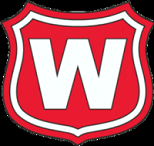
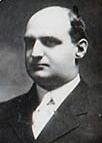

On Dec. 1, 1903 the Montreal Wanderers AKA the Redbands amateur ice hockey team is founded in Montreal, Quebec, Canada by James F. Strachan (1876-1939), playing their home games in the Montreal Arena until Nov. 1909. when it is sold to P.J. Doran; it folds in 1918 after the Montreal Arena burns down, resuming operations in 1924 under the name Montreal Maroons (Montreal Prof. Hockey Club), backed by the English-speaking community of Montreal against French-speaking favorite Montreal Canadiens, playing their home games in the new $1.5M Montreal Forum (opened Nov. 29, 1924); they suspend play in 1938, and their franchise is cancelled in 1947.
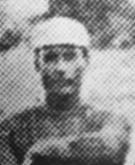
On Dec. 5, 1903 the Federal Amateur Hockey League (FAHL) is founded in Montreal for teams rejected by the rival Canadian Amateur Hockey League (CAHL), incl. the Montreal Wanderers, Ottawa Capitals, Montreal Le National, and Cornwall Hockey Club; in 1904 Montreal Le National jumps to the CAHL, while the CAHL Stanley Cup champion Ottawa Hockey Club jumps to the FAHL, defeating the Montreal Wanderers on Mar. 2 to become FAHL champion; too bad, the on-ice death of Owen "Bud" McCourt (1884-1907) of Cornwall on Mar. 6, 1907 after a brawl causes the 1906-7 season to be suspended, after which the FAHL goes pro in 1908 under the name Federal Hockey League (FHL) , signing the Renfrew Creamery Kings to bring it back to four teams, pissing-off the Ottawa Victorias, who refuse to play them, causing the 1908-9 season to be suspended; in 1909 the Ottawa Senators join, after which the FAHL dissolves, ending the season.
On Jan. 2-Feb. 24, 1904 the 1904 Canadian Amateur Hockey League (CAHL) Season sees the Ottawa Hockey Club (Silver Seven) resign in Feb., defaulting on four games, giving the Quebec Bulldogs the CAHL championship; Ottawa retains the Stanley Cup despite a protest by Quebec.
On Jan. 2-Mar. 11, 1905 the 1905 Canadian Amateur Hockey League (CAHL) Season (7th and last) sees the Montreal Victorias win with a 9-1 record; after a rules dispute, no Stanley Cup game is played; on Jan. 13-16, 1905 after the Dawson City Nuggets travel 4K mi. by dogsled to Ottawa, the 1905 Stanley Cup Finals see the Ottawa Senators defeat the Dawson City Nuggets 9-2 and 23-2 (largest margin of victory until ?).
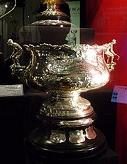
On Dec. 11, 1905 the Eastern Canada Amateur Hockey Assoc. (ECAHA) amateur ice hockey league is founded by two teams from the Federal Amateur Hockey League (FAHL) and four from the Canadian Amateur Hockey League (CAHL), going pro for the 1908 season after the amateur Montreal Victorias and Montreal Hockey Club leave in protest for other teams using pro players, changing its name to the Eastern Canada Hockey Assoc., then dissolving in Jan. 1909 after poor game attendance; in 1906 the Arena Cup is donated by the Montreal Arena Co., made from 90 oz. (2.6kg) of sterling silver; in 1908 after winning it for three straight seasons, it is given to the Montreal Wanderers.
The 1906 Stanley Cup is won by the Montreal Wanderers.
The 1907 Stanley Cup is won by the Montreal Wanderers.
On Nov. 29, 1907 the Alberta Amateur Hockey Assoc. (AAHA) is founded in Red Deer, Canada by the Edmonton Hockey Club, Calgary Shermans et al.
On Jan. 2, 1908 after the Eastern Canada Amateur Hockey Assoc. (ECAHA) permits teams to openly pay players, the first Ice Hockey All-Star Game is planed before 3.5K fans at Montreal Arena; the Montreal Wanderers defeat the All-Stars 10-7. The 1908 Stanley Cup is won by the Montreal Wanderers.
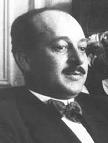
On May 15, 1908 the Internat. Ice Hockey Federation (IIHF) (originally Ligue International de Hockey sur Glace) is founded in Paris France by reps from France, Belgium, Britain, Bohemia, and Switzerland, with Kingston, Jamaica-born figure skater Louis Magnus (1881-1950) as pres. #1 (until 1912, then again in 1914); it goes on to have little authority over hockey in North Am.
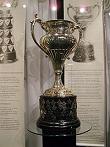

On Nov. 14, 1908 after getting disgusted with the paying of players and resigning from the Eastern Canadian Amateur Hockey Assoc. (ECAHA), the Montreal Victorias, Montreal Hockey Club, Ottawa Cliffsides, and Toronto Amateur Athletic Club found the Interprovincial Amateur Hockey Union (IPAHU), starting their first season in Jan. 1909; in Feb. 1909 the Allan Cup is established for senior amateur hockey teams from Canada by steamship line heir Lt.-Col. Sir Hugh Andrew Montague Allan (1860-1951) of Ravenscrag, Montreal; the first winner is the Montreal Victorias; in 1910-11 the league grows to eight teams, followed in 1911-12 to 13.


In 1909 5'10" center Maurice Joseph Cletus "Phantom Joe" Malone (1890-1969), known for his clean play begins playing for the Quebec Bulldogs of the Eastern Canada Hockey Assoc. (ECHA), scoring 8 goals in 12 games, becoming the team captain and leading them to the 1912 and 1913 Stanley Cup Finals, scoring a record 9 goals in a Cup match against Sydney; in 1913 his older brother Patrick Jeffrey Elias "Jeff" Malone (1888-1981) helps him win the Stanley Cup; in 1917 he joins the NHL Montreal Canadiens, shifting to left wing to play with Newsy Lalonde and Didier Pitre, scoring an NHL record 44 goals in 20 games that stands until 1945, along with a record per-game avg. that isn't broken until ?; he also scores 1+ goal in each of his first 14 NHL games (total 35), setting an NHL record for longest goal-scoring streak; in 1919 he returns to Quebec, leading the NHL with 39 goals, and setting an NHL single game record of 7 goals on Jan. 31, 1920 against Toronto.
The 1909 Stanley Cup is won by the Ottawa Senators, becoming the 4th and last season of the Eastern Canada Hockey Assoc.
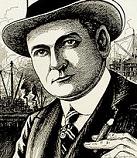
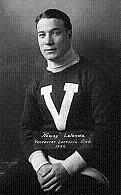



In 1909 John Ambrose O'Brien (1885-1968) of Renfrew, Ont., Canada buys the Renfrew Creamery Kings, which get the nickname Renfrew Millionaires after he gives lavish contracts to its players in an unsuccssful bid for the Stanley Cup, incl. "Flying Frenchman" Edouard Cyrille "Newsy"" Lalonde (1887-1970), brothers Cutis Lester "Les" "the Silver Fox" Patrick (1883-1960) and Francis Alexis "FranK" Patrick (1885-1960), and Frederick Wellington "Fred" "Cyclone" Taylor (1884-1979).
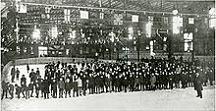
In Nov. 1909 the Montreal Wanderers are sold to P.J. Doran, who moves their home games to the new Jubilee Arena (Rink), which only seats 3.2K (vs. 10K for the Montreal Arena), pissing-off the other three Eastern Canada Hockey League members (Ottawa Hockey Club, Quebec Bulldogs, Montreal Shamrocks), who on Nov. 25 dissolve it and form the Canadian Hockey Assoc. (CHA), causing the Wanderers to move to the new Nat. Hockey Assoc. (NHA).
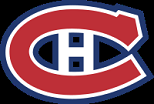
On Dec. 2, 1909 after being turned down by the new Canadian Hockey Assoc. (CHA), John Ambrose O'Brien founds the Nat. Hockey Assoc. (NHA) in E Canada (until Dec. 11, 1918), incl. his Renfrew Millionaires, the Montreal Wanderers, and his new Montreal Canadiens (founded Dec. 4), which becomes the oldest prof. ice hockey team to survive to modern times; too bad, the CHA folds in Jan. 1910 after seven weeks after their first game on Dec. 30, 1909 is attended by only 800 fans, and the Jan. 8 game by only 1,500 fans, causing three of its five teams (Ottawa Hockey Club, Quebec Bulldogs, Montreal Shamrocks) to jump to the NHA on Jan. 15.
The 1910 Stanley Cup is won by the Montreal Wanderers.
In 1910 Canadian hockey star Lester Patrick and his entire family incl. father Joseph and sisters Cynda, Dora, and Myrtle found the British Columbia Ladies Hockey Club, with Lester as coach and Dora as capt.


In 1911 the Pacific Coast Hockey Assoc. (PCHA) is organized by wealthy Canadian lumberman Joseph "Joe" Patrick (1857-1941) and his sons Curtis Lester "Les" "the Silver Fox" Patrick (1883-1960) and Francis Alexis "Frank" Patrick (1885-1960) for pro hockey players in W Canada incl. Seattle, Wash., becoming rivals with the NH and NHL, building the first artificial ice rinks in Vancouver, B.C. and Victoria, B.C.; Joe invents the idea of putting numbers on player uniforms; Lester invents 22 new rules incl. the blue line, forward pass, playoff system (soon adopted by other sports leagues), penalty shot, the rule allowing the puck to be kicked everywhere but into the net, a rule allowing goaltenders to fall to the ice to make a save, and the policy of crediting assists, causing him to be called "the Brains of Modern Hockey"; in 1924 it merges with the Western Canada Hockey League (WCHA).
In 1911 after the Edmonton Hockey Club folds, the Edmonton Eskimos Canadian amateur ice hockey team is founded; after going pro, it folds in 1927.
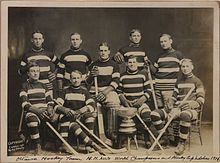
The 1911 Stanley Cup is won by the Ottawa Hockey Club.

In 1911 Nat. Hockey Assoc. (NHA) players strike for increased pay, led by 5'11" Montreal Wanderers defenceman Arthur Howey "Art" Ross (1886-1964), who goes on to become the first head coach of the Boston Bruins in 1924-45, then remain as gen. mgr. until his 1954 retirement, inventing the official NHL puck with bevelled edges.
On Mar. 11-13, 1912 (first season with numbers attached to player jerseys, the LeSeur goal, and the Spalding puck) the 1912 Stanley Cup Finals see the Quebec Bulldogs defeat the Moncton Victorias 2-0.
On Mar. 8-10, 1913 the 1913 Stanley Cup Finals see Quebec Bulldogs defeat the Sydney Millionaires 2-0, becoming a 2-peat.
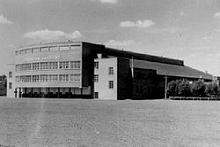
On Dec. 13, 1913 Edmonton Gardens (originally the Edmonton Stock Pavilion) AKA the Cow Barn in Edmonton, Alberta, Canada (cap. 5.2K) opens as their first indoor hockey arena, becoming home to the Edmonton Oil Kings, Edmonton Eskimos, Edmonton Flyers, and Edmonton Oilers; in 1966 after the fire dept. condemns it, it is renovated; it is demolished in Feb. 1982 by a wrecking ball after two failed attempts with dynamite.
On Mar. 14-19, 1914 the 1914 Stanley Cup Finals (first between the NHA and PCHA) see the Toronto Hockey Club (NHA) defeat the Victoria Aristocrats (PCHA) 3-0.
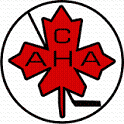
In 1914 the Canadian Amateur Hockey Assoc. (CAHA) is founded at the Chateau Laurier Hotel in Ottawa, Ont. as the governing body of amateur ice hockey in Canada; in 1994 it merges with Hockey Canada.
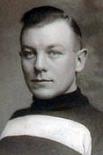
On Mar. 22-26, 1915 the 1915 Stanley Cup Finals see the Vancouver Millionaires (PCHA) defeat the Ottawa Senators (NHA) 3-0, becoming the first PCHA team to win the title; all three Ottawa goals are scored by 5'7" right wing Harold Lawton "Harry" "Punch" Broadbent (1892-1971), who pioneers the power forward position, scoring an NHL record 1+ goals in 16 straight games in 1922 before being traded to the Montreal Maroons in 1925 and helping them win the 1926 Stanley Cup.
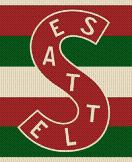
In 1915 the Seattle Metropolitans ice hockey team is founded to play in the Pacific Coast Hockey Assoc. (PCHA) (until 1924); home games are played at the Seattle Ice Arena.
On Mar. 20-30, 1916 the 1916 Stanley Cup Finals see the Montreal Canadiens (NHA) defeat the Portland Rosebuds (PCHA) 3-2, becoming their 1st title.
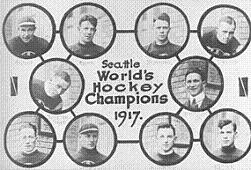

On Mar. 17-26, 1917 the 1917 Stanley Cup Finals in the Seattle Ice Arena see the Seattle Metropolitans of the PCHA defeat the Montreal Canadiens of the NHA 3-1, becoming the first U.S.-based team to win; the combined score is 19-3, of which 14 of Seattle's goals are scored by 5'7" center Bernard Patrick "Bernie" Morris (1890-1963).
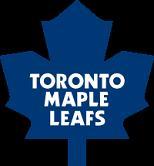
On Nov. 22, 1917 the Toronto Maple Leafs NHL team is founded as the Toronto Arenas, changing to the Toronto St. Patricks in 1919, and the Toronto Maple Leafs in 1927.
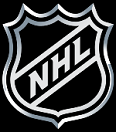
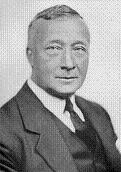
On Nov. 26, 1917 the Nat. Hockey League (NHL) is founded in Montreal, Quebec, replacing the Nat. Hockey Assoc. in Canada; pres. #1 (1917-43) is Bristol, England-born Frank Sellick Calder (1877-1943); the season typically starts soon before/after the ML baseball World Series.
On Mar. 20-30, 1918 the 1918 Stanley Cup Finals in Arena Gardens in Toronto see the Toronto team of the NHL defeat the Vancouver Millionaires of the PCHA 3-2, becoming their first title, and the first NHL team to win the title.
On Mar. 19-29, 1919 the 1919 Stanley Cup Finals see the Montreal Canadiens of the NHL and the Seattle Metropolitans of the PCHA tie 2-2 after the series is suspended due to an influenza outbreak, becoming the first Finals no-decision until ?.



In Dec. 1919 after joining the Ontario Hockey Assoc. in 1916 then turning pro and joining the NHL Toronto Arenas in 1917, 5'9" center John James "Jack" Adams (1895-1968) joins the Vancouver Millionaires, leading the NHL in scoring in the 1921-22 season, centering a line with right wing Alfred "Al" "Dutch" Skinner (1894-1961) and left wing Thomas Wilfred "Smokey" "Fred" Harris (1890-1974) before switching to the Toronto St. Patricks in 1922, becoming their leading scorer in the 1925-6 season, then finishing his career with the Ottawa Senators in 1927 with the Ottawa Senators.
In 1919 the Memorial Cup (originally Ont. Hockey Assoc. Memorial Cup) is established by the Canadian Hockey League (CHL) for the junior hockey champion of Canada; the Canadian Amateur Hockey Assoc. (CAHA) become the cup's trustees until 1985, when it is entrusted to the Canadian Hockey League (CHL).
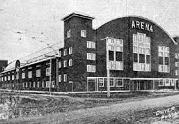
In 1919 after the Stanley Cup is no longer awarded to the top amateur hockey team in Canada but is reserved for the pro Nat. Hockey League (NHL) and Pacific Coast Hockey Assoc. (PCHA), the elite senior amateur Big Four (Big-4) League is founded in Alberta by the new Calgary (Bengal) Tigers (folds 1927), Calgary Canadians, Edmonton Eskimos, and Edmonton Dominions to compete for the Allan Cup; the Calgary teams play home games at the Victoria Arena (built in 1914 for the Canadian army as the Horseshoe Arena); too bad, it folds in 1921 amid allegations of secretly employing pros to win, turning it into a "shamateur" league.
In 1919 the Northern Ontario Hockey Assoc. (NOHA) is founded for minor and junior level ice hockey, affiliating with the Ontario Hockey Assoc. (OHA).
On Mar. 22-Apr. 1, 1920 the 1920 Stanley Cup Finals see the Ottawa Senators of the NHl defeat the Seattle Metropolitans of the PCHA 3-2, becoming the last Finals appearance by a West Coast U.S.-based team until 1993; the Ottawa Senators become the first NHL dynasty in 1919-27.







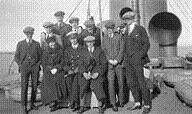
On Aug. 14-Sept. 12, 1920 after an 8-year hiatus the VII (7th) Summer Olympic Games are held in Antwerp, Belgium (to honor WWI suffering), with 2,626 athletes from 29 nations participating in 156 events in 22 sports; Germany, Austria, Hungary, Turkey, and Bulgaria are banned; the Olympic Oath is first uttered, the Olympic Flag is first flown, and doves are first released to symbolize peace; the U.S. team revolts against its barracks-style living quarters and threatens to boycott the games; the U.S. wins the most events, with 41 golds, 27 silvers, and 27 bronzes; figure skating and ice hockey debut; Finnish runner Paavo Nurmi (1897-1973) debuts, winning the first of six gold medals (1920, 1924, 1928), and breaking U.S. dominance in track and field with nine medals; Ethelda M. Bleibtrey (1902-78), who was arrested in 1919 for nude bathing for swimming without stockings wins three golds (100m, 300m, 400m relay) in swimming, becoming the first U.S. woman to win Olympic gold, and one of the first women to wear a flapper "bob"; Albert George Hill (1889-1969) of Britain wins golds in the 800m and 1500m, and silver in the 3000m; "the Calif. Cannonball" Charles William "Charlie" Paddock (1900-43) of the U.S. wins the 100m in 8.3 sec.; his teammate "the New York Thunderbolt" Jackson Volney Scholz (1897-1986) makes a mistake and looks at him and comes in 2nd at 8.4; 72-y.-o. Oscar Gomer Swahn (1847-1927) of Sweden becomes the oldest Olympic gold medal winner (team double-shot running deer event) (until ?); the last Olympics to host the tug-of-war event (Britain gold, Netherlands silver, Belgium bronze). figure skating makes its debut; Canada (WInnipeg Falcons) win the gold medal in the debut of Olympic ice hockey, followed by the U.S. and Czech.
On Mar. 21-Apr. 4, 1921 the 1921 Stanley Cup Finals see the Ottawa Senators of the NHL defeat the Vancouver Millionaires of the PCHA 3-2, becoming their 2nd straight.
In 1921 after the Big Four League collapses on allegations of paying amateurs, the prof. West Canada Hockey League (WCHL) is founded by the Edmonton Eskimos, Calgary Tigers, Regina Capitals, and Saskatoon (later Moose Jaw) Sheiks, playing 6-man hockey without a rover; the league winner plays the winner of the Pacific Coast Hockey Assoc., and the winner of that plays against the NHL winner for the Stanley Cup; in 1925 it becomes the Western Hockey League before it is disbanded in 1926.
On Mar. 17-28, 1922 the 1922 Stanley Cup Finals in Arena Gardens in Toronto see the Toronto St. Patricks of the NHL defeat the Vancouver Millionaires of the PCHA 3-2; Vancouver center Jack Adams is the star, scoring 6 goals.
On Mar. 29-31, 1923 the 1923 Stanley Cup Finals in Denman Arena in Vancouver see the Ottawa Senators of the NHL defeat the Edmonton Eskimos of the WCHL 2-0, becoming the last Final until 1983 with a team from Edmonton.

In 1923 5'9" center ("the Stratford Streak") ("the Mitchell Meteor") Howard William "Howie" Morenz (1902-37) begins playing for the Montreal Canadiens, leading them in goals and points for seven seasons, and helping them win three Stanley Cups, winning league MVP 3x, playing for 14 seasons until his leg is fractured in four places by Chicago Black Hawks player Earl Seibert on Jan. 28, 1937, dying of a heart attack in the hospital on Mar. 8, after which 50K attend his funeral on Mar. 11 at the Montreal Forum, and his jersey number #7 is retired by the Canadiens (first time for any player), becoming of the first 12 players inducted into the Hockey Hall of Fame in 1945; the Canadian Press calls him the best ice hockey player of the first half of the 20th cent.
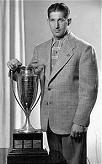

On Mar. 22-25, 1924 the 1924 Stanley Cup Finals see the Montreal Tigers of the NHL defeat the Calgary Tigers of the WCHL 2-0, becoming their 2nd title; the last Final until 1983 with a team from Alberta, and the last Final until 1986 with a team from Calgary; after the 1923-4 season the Hart Memorial Trophy is established by the NHL for the "player judged most valuable to his team"; it is first awarded to 5'9" center Julius Francis "Frank" "Pembroke Peach" Nighbor (1893-1966) of the Ottawa Senators; in 1960 the original trophy is retired and a new one substituted.



In 1924 Boston becomes the first U.S. city to join the Nat. Hockey League (NHL) (founded 1917), with the Boston Bruins, who play their home games at Boston Arena, winning their first game against the Montreal Maroons on Dec. 1, 1924 by 2-1 before end up last place for the season with a 6-24 record; first gen. mgr. is former star player Arthur Howey "Art" Ross (1886-1964), who becomes coach 4x until his 1945 retirement; in 1928 they move to the $10M Boston Garden (opened Nov. 17, 1928), losing their first game on Nov. 20, 1928 to the Montreal Canadians 1-0.
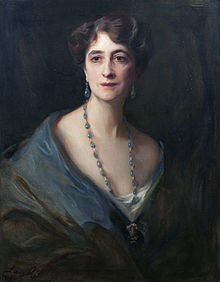

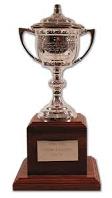
On Mar. 21-30, 1925 the 1925 Stanley Cup Finals see the Victoria Cougars of the Western Canada Hockey League (WCHL) defeat the Montreal Canadiens of the NHL 3-1, becoming the last non-NHL team to win the Cup, and the last team based W of Chicago, Ill. to win until the Edmonton Oilers in 1984; after the 1924-25 season the Lady Byng Memorial Trophy, named for Marie Evelyn Byng (nee Moreton), Viscountess Byng of Vimy (1870-1949), wife of Canadian gov.-gen. (1921-6) Viscount Byng of Vimy is established by the NHL for the "player adjuged to have exhibited the best type of sportsmanship and gentlemanly conduct combined with a high standard of playing ability" as voted by members of the Prof. Hockey Writers Assoc.; the first award goes to Frank Nighbor of the Ottawa Senators; Frank Boucher wins in 1928-35, causing Lady Byng to give him the trophy permanently; too bad, it is destroyed in a fire at his home in 1962; meanwhile new trophies are created in 1936 and 1949; no goaltender wins until ?.
On Mar. 30-Apr. 6, 1926 the 1926 Stanley Cup Finals see the Montreal Maroons defeat the Victoria Cougars 3-1.
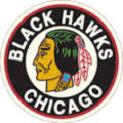

In 1926 the Chicago Black Hawks NHL team is founded, becoming the Chicago Blackhawks in 1986; the first team captain is 5'9" center James Dickinson Irvin "Dick" Irvin Jr. (1892-1957) of the Regina Victorias, who is forced into early retirement after the 1929 season due to a skull fracture in his 2nd season, becoming the team's head coach in 1930-1, followed by the Toronto Maple Leafs in 1931-1940, and the Montreal Canadiens in 1940-55, stinking himself up by encouraging goon tactics.
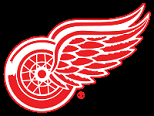
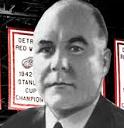

In 1926 the Detroit Red Wings NHL team is founded as the Detroit Cougars, becoming the Detroit Falcons in 1930-2, and the Detroit Red Wings in 1932 after Chicago grain-cattle dealer James E. Norris (1879-1952) buys it and pumps up the financing; meanwhile in 1927 retired player John James "Jack" Adams (1895-1968) is hired as coach and gen. mgr. of the Detroit Cougars, staying on until 1963, becoming known as "Trading Jack" for his habit of keeping his team on their toes with blockbuster trades; from 1932-47 Adams works on a 1-year handshake contract.
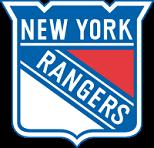
In 1926 the New York Rangers NHL team is founded, playing home games at Madison Square Garden, going on to become the first U.S.-based team to win the Stanley Cup.


In 1926 after the Western Hockey League folds along with the Edmonton Eskimos, 5'11" bruiser defenceman Edward William "Eddie" "the Edmonton Express" Shore (1902-85) is sold to the Boston Bruins, almost getting his ear ripped off by 5'11 bruiser defenceman Wilfrid Arthur "Billy" "Wild Beaver" Coutu (1892-1977) during practice, then scoring 12 goals and six assists as a rookie while accumulating 130 penalty minutes, setting an NHL record for 165 penalty minutes in his 2nd season, and helping them win their first Stanley Cup in 1929, going on to win the Hart Trophy 4x and get named to the NHL All-Star Team in eight of his last nine seasons before retiring in 1940; in 1927 Coutu becomes the first NHL player banned for life (until ?) for attacking a referee at the end of game 4 of the 1927 Stanley Cup Finals.

In 1926 5'10" right wing Irvine Wallace "Ace" Bailey (1903-92) joins the Toronto Maple Leafs (originally the Toronto St. Patricks), becoming the NHL's leading scorer in the 1928-9 season with 22 goals and 32 points in 44 games, doing ditto in 1929-30, and one point short of doing ditto in 1930-1, helping win the Stanley Cup in 1932; too bad, on Dec. 13, 1933 he is hit from behind by Eddie Shore of the Boston Bruins for tripping King Clancy, and fractures his skull on the ice, ending his career after 111 goals and 82 assists in 313 games, after which an all-star benefit game is held at Maple Leaf Gardens on Feb. 14, 1934 that raises $21K for him and his family, at which he shakes hands with Shore; his #6 jersey becomes the first to be retired by an NHL team.

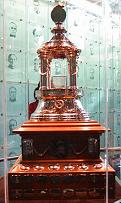
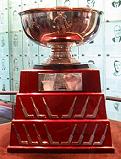
On Apr. 4-13, 1927 the 1927 Stanley Cup Finals (first with two NHL teams after the Western Hockey League folded in 1926) see the Ottawa Senators defeat the Boston Bruins 2-0, becoming their 11th title, 4th since 1920, and last; the last Finals appearance by a team from Ottawa until 2007; after the 1926-27 season the Vezina Trophy, named after late Montreal Canadiens goalie (1910-25) ("the Chicoutimi Cucumber") Joseph Georges Gonzague Vezina (Vézina) (1887-1926) is established by the NHL for the goaltender who is "adjudged to be the best at this position" as voted by gen. mgrs.; the first award goes to George Hainsworth of the Montreal Canadiens, who also wins in 1928 and 1929; in 1946 they change the criterion to the goalie playing the most games for the team that has the fewest goals scored against it during the regular season; Jacques Plante wins in 1956-9, 1962, and 1969; in 1965 teammate goalies who play 25+ games are allowed to share it; the last award goes to Michel Larocque and Richard Sevigny of the Montreal Canadiens in 1981; after the 1981-2 season the William M. Jennings Trophy is established by the NHL for the starting goaltender(s) only; the first award goes to Rick Wamsley and Denis Herron of the Montreal Canadiens (223 goals allowed).

In 1927 Brussels, Belgium-born Paul Loicq (1888-1953) becomes pres. of the Internat. Ice Hockey Federation (IIHF) (until 1947), helping increase hockey's popularity in Europe.

On Apr. 5-14, 1928 the 1928 Stanley Cup Finals see the New York Rangers (first Finals appearance) defeat the Montreal Maroons 3-2, becoming their first title, and 2nd by a U.S.-based team since the Seattle Metropolitans in 1917; on Apr. 8 after Rangers goaltender Lorne Chabot is hit in the eye by a puck in the 2nd period, old fart coach Curtis Lester "Les" "the Silver Fox" Patrick (1883-1960) steps in his place, saving 18 of 19 goals, becoming the oldest goaltender to play in the Finals (until ?).
On Mar. 28-29, 1929 the 1929 Stanley Cup Finals (first Finals with two U.S.-based teams)see the Boston Bruins defeat the New York Rangers 2-0, becoming their first title.
On Apr. 1-3, 1930 the 1930 Stanley Cup Finals see the Montreal Canadiens defeat the Boston Bruins 2-0, becoming their 3rd title.
On Apr. 3-14, 1931 the 1931 Stanley Cup Finals see the Montreal Canadiens defeat the Chicago Black Hawks (first Finals appearance) 3-2, becoming the 2nd NHL 2-peat.
At the end of the 1930-1 season the first NHL All-Star Team is named.
On Apr. 5-9, 1932 the 1932 Stanley Cup Finals see the Toronto Maple Leafs defeat the New York Rangers 3-0, becoming their first title.
On Apr. 4-13, 1933 the 1933 Stanley Cup Finals (first best-of-four Finals series) see the New York Rangers defeat the Toronto Maple Leafs 3-1, becoming their 2nd title.
On Apr. 3-10, 1934 the 1934 Stanley Cup Finals see the Chicago Black Hawks (2nd Finals appearance) defeat the Detroit Red Wings (first Finals appearance) 3-1.
On Apr. 4-9, 1935 the 1935 Stanley Cup Finals see the Montreal Maroons defeat the Toronto Maple Leafs 4-3, becoming their 2nd and last title as they disband in 1938, becoming the last defunct team to win the title (until ?).
On Apr. 5-11, 1936 the 1936 Stanley Cup Finals see the Detroit Red Wings defeat the Toronto Maple Leafs 3-1, becoming their first title.
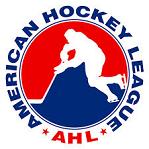

In 1936 the Am. Hockey League (AHL) (originally the Internat.-Am. Hockey League until 1940) is formed from the merger of the Canadian-Am. Hockey League (founded 1926) (Springfield Indians, Philadelphia Ramblers, Providence Reds, New Haven Eagles) and the Internat. Hockey League (founded 1939) (Buffalo Bisons, Syracuse Stars, Pittsburgh Hornets, Cleveland Falcons), expanding to 12 teams in 1970, 27 in 2002, and 30 by 2015 (three in Canada, 27 in the U.S.); starting in the 2010-11 season every AHL team is affiliated with an NHL team as its farm team.
On Apr. 6-15, 1937 the 1937 Stanley Cup Finals see the Detroit Red Wings defeat the New York Rangers 3-2, becoming their 2nd straight title.
After the 1936-7 season the NHL Calder Cup (Memorial Trophy) (named after pres. #1 of the NHL Frank Calder) is established for "the player selected as the most proficient in his first year of competition in the National Hockey League"; the first winner is Syl Apps of the Toronto Maple Leafs; meanwhile the AHL Calder Cup is established by the Am. Hockey League (AHL) for their playoff champion team; the first one is awarded to the Syracuse Stars after they defeat the Philadelphia Ramblers 3-1.



In 1937 the Kraut Line (a reference to their German descent) of the Kitchener Greenshirts of the Ontario Hockey Assoc. (OHA), incl. 6'0" center Milton Conrad "Milt" Schmidt (1918-), 6'1" left wing Woodrow Wilson Clarence "Woody" "Porky" Dumart (1916-2001), and 5'7" right wing Robert Theodore "Bobby" Bauer (1915-64) are signed by the NHL Boston Bruins, living together in a 1-room apt. in Brookline, Mass., helping win the Stanley Cup in 1939 and 1941, and going 1-2-3 in scoring in the 1939-40 season; on Feb. 11, 1942 they play their last game before enlisting with the Royal Canadian Air Force (until 1946).
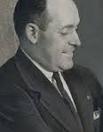
On Apr. 5-12, 1938 the 1938 Stanley Cup Finals see the Chicago Black Hawks defeat the Toronto Maple Leafs 3-1, becoming their 2nd title; Game 3 features a record eight Am. players for Chicago, and a record attendance of 18,497; the last Chicago team to win a championship at Chicago Stadium until the 1992 Bulls; the last Chicago Stanley Cup win at home until 2015; the NHL forgets to bring the Cup to Chicago before the Apr. 12 game; Fitchburg, Mass.-born William Joseph "Bill" Stewart (1894-1964) becomes the first U.S-born and 5th NHL rookie coach to win the title until Bob Johnson in 1991, also the first U.S.-born mgr. to win the Cup until Brian Burke in 2007.

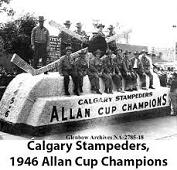
In 1938 the Calgary Stampeders amateur ice hockey team is founded in Calgary, Alberta, Canada, going on to win the Allan Cup in 1946, becoming the first Alberta-based club to win; in 1951 they go pro and join the Pacific Coast Hockey League as the farm team for the Chicago Black Hawks; it folds in 1972.
On Apr. 6-16, 1939 the 1939 Stanley Cup Finals (first best-of-seven Finals) see the Boston Bruins defeat the Toronto Maple Leafs 4-1.
On Apr. 2-13, 1940 1940 Stanley Cup Finals see the New York Rangers defeat the Toronto Maple Leafs 4-2, starting a title drought until 1994 called Dutton's Curse (The Curse of 1940).
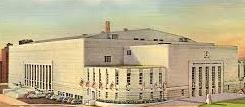
On Oct. 14, 1940 the $2.7M Buffalo Memorial Auditorium, AKA the Aud in Buffalo, N.Y. opens as the home of the AHL Buffalo Bisons, later the Buffalo Sabres in 1970; it closes in 1996, and is demolished in 2009.
In 1940 the Edmonton Flyers amateur ice hockey team is founded in Edmonton, Alberta, Canada, going on to win the 1948 Allan Cup; in 1951 they go pro and join the Pacific Coast Hockey League as the farm team of the Detroit Red Wings; they fold in 1963.
On Apr. 6-12, 1941 the 1941 Stanley Cup Finals see the Boston Bruins sweep the Detroit Red Wings 4-0.
On Apr. 4-18, 1942 the 1942 Stanley Cup Finals see the Toronto Maple Leafs defeat the Detroit Red Wings 4-3 after losing the first three games, becoming the first to go to seven games; Red Wings coach (1927-63) Jack Adams punches a referee in Game 3, becoming the first coach to be suspended in a Final.
In the 1942-3 season the Original Six Era in the NHL begins, incl. the Boston Bruins, Chicago Black Hawks, Detroit Red Wings, Montreal Canadiens, New York Rangers, and Toronto Maple Leafs, which ends with the 1967-8 expansion into 12 teams.
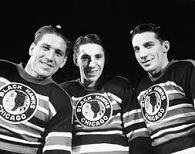
On Jan. 1, 1943 5'8" right wing Reginald Stewart "Reg" Bentley (1914-80) (NHL scoring leader in 1942-3 with 73 points), 5'8" left wing Douglas Wagner "Doug" Bentley (1916-72), and 5'9" center Maxwell Herbert Lloyd "Max" Bentley (1920-84) (#3 in the NHL in scoring in 1942-3 with 70 points), become the first NHL all-brother line, playing for the Chicago Black Hawks; on Jan. 3 Max and Doug assist Reg on his first and only NHL goal; Reg only plays 11 games before joining the Canadian army to play on exhibition teams; Max is traded to the Toronto Maple Leafs in 1947, playing on three Stanley Cup teams.

On Jan. 14, 1943 Montreal Canadiens forward Alex Smart (1918-2005) becomes the first NHL player to score a hat trick in his first game (next 1979).
On Apr. 1-8, 1943 the 1943 Stanley Cup Finals see the Detroit Red Wings defeat the Boston Bruins 4-0, becoming their 3rd title.
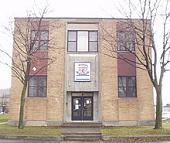
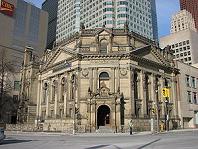
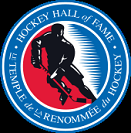
On Sept. 10, 1943 the Internat. Hockey Hall of Fame and Museum in Kingston, Ont., Canada opens, inducting its first class in 1945; in 1958 it moves to Toronto, Ont., becoming the Hockey Hall of Fame, whose 18-member committee meets annually in June to select new honorees in the categories of players, builders (coaches, gen. mgrs., commentators, owners), or on-ice officials; in 2010 the new category of female players is established.
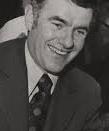
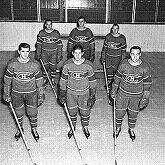
In the 1943-4 NHL season Montreal Canadiens head coach (1940-55) James Dickinson Irvin "Dick" Irvin Jr. (1892-1957) creates the Punch Line, consisting of 5'10" center Elmer James Lach (1918-2015), 5'10" left wing Joseph Hector "Toe" Blake (1912-95), and 5'10" right wing Joseph Henri Maurice "Rocket" Richard (1921-2000), dominating the NHL for four seasons; it becomes kaput after Blake retires after the 1947-8 season.
On Apr. 4-13, 1944 the 1944 Stanley Cup Finals see the Montreal Canadiens sweep the Chicago Black Hawks 4-0, becoming their first title since 1931.



In 1944 5'8" left wing Robert Blake Theodore "Terrible Ted" Lindsay (1925-) makes his debut with the Detroit Red Wings, becoming part of the 1947-52 Production Line with 5'11" center Sidney Gerald "Sid" Abel (1918-2002) and 5'0" right winger Gordon "Gordie" Howe (1928-2016), becoming known for his rough play, causing the NHL to enact penalties for elbowing and kneeing.

In the 1944-5 season 5'10" "Canadian hockey hall-of-fame right wing (Montreal Canadiens #9, 1942-60) Joseph Henri Maurice "Rocket" Richard (1921-2000) becomes the first NHL player to score 50 goals in a season; in the 1957-8 season he becomes the first NHL player to achieve 500 career goals, retiring in 1960 with 544 career goals after his vicious attack on a linesman late in the 1954-55 season results in his suspension, causing the Richard Riot in Montreal, becoming a precursor to the Quiet Rev.
On Apr. 6-22, 1945 the 1945 Stanley Cup Finals see the Toronto Maple Leafs defeat the Detroit Red Wings 4-3.
On Mar. 30-Apr. 9, 1946 the 1946 Stanley Cup Finals see the Montreal Canadians defeat the Boston Bruins 4-1.


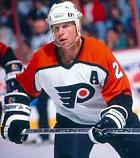
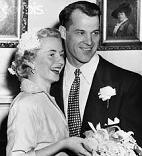
On Oct. 16, 1946 6'0" right winger Gordon "Gordie" Howe (1928-2016) makes his debut with the Detroit Red Wings at age 18, scoring a goal; he goes on to play for the Red Wings for 25 seasons, earning the nickname "Mr. Hockey", retiring in 1980 after setting a ton of NHL scoring records that stand until Wayne Gretzky breaks them in the 1990s, incl. most points in a season (95 in 1953); in 1971 he retires, is inducted into the Hockey Hall of Fame in 1972, then comes back in 1973 with the WHA Houston Aeros, playing with his sons Marty Gordon Howe (1954-) and Mark Steven Howe (1955), scoring 100+ points 2x by 1979, then playing for one season in 1980 with the Hartford Whalers before permanently retiring, becoming the first NHL player to compete in five different decades (until ?); his wife (1953-2009) Colleen Joffa Howe (1933-2009) goes on to become known as "Mrs. Hockey", bringing the first Junior A hockey team to the U.S., and building the first indoor public rink in Mich.
On Apr. 8-19, 1947 the 1947 Stanley Cup Finals (first all-Canadian finals since 1935) see the Toronto Maple Leafs defeat the Montreal Canadiens 4-2, becoming the 2nd NHL dynasty (1947-51).
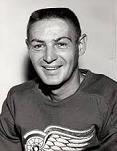

In 1947 after being signed to an amateur contract at age 14, 5'11" Ukrainian-descent goalie Terrance Gordon "Terry" "Uke(y)" Sawchuk (1929-70) (known for stopping pucks with his well-sawed and well-chucked unmasked face, receiving 400 stitches incl. three in his right eyeball before donning a facemask in 1962) signs with the Detroit Red Wings (#1), winning the Calder Trophy for rookie of the year then going on to lead them to three Stanley Cups in five years, dying on May 31,1970 after a fight with a teammate, compiling a career record 103 shutouts.

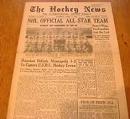
In 1947 The Hockey News (THN) is founded in Canada by Ken McKenzie (1923-2003), becoming the #1 ice hockey mag. in North Am., with 225K circ. by modern times.
On Apr. 7-14, 1948 the 1948 Stanley Cup Finals see the Tornoto Maple Leafs sweep the Detroit Red Wings 4-9, becoming a 2-peat.

After the 1947-8 season the Art Ross Trophy, named after Boston Bruins coach (1924-45) Arthur Howey "Art" Ross (1886-1964) (designer of the official bevelled-edge NHL puck) is established by the NHL for the player with the most points in the season; the first award goes to Elmer Lach of the Montreal Canadiens (61 points).
On Apr. 8-16, 1949 the 1949 Stanley Cup Finals see the Toronto Maple Leafs sweep the Detroit Red Wings 4-9, becoming a 3-peat.
On Apr. 11-23, 1950 the 1950 Stanley Cup Finals see the Detroit Red Wings defeat the New York Rangers (first Finals appearance since 1940) 4-3, becoming the 3rd NHL dynasty in 1950-5.

In 1950 6'3 center Joseph Jean Arthur "Le Gros Bill" Beliveau (Béliveau) (1931-2014) is drafted by the Montreal Canadiens, going on to become the 2nd NHL player to score 1K points and the 4th to score 500 goals, winning 10 Stanley Cups before retiring in 1971.
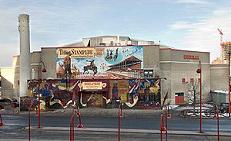
On Dec. 15, 1950 the $1.25M Stampede Corral in Calgary, Alberta, Canada (cap. 6,475) opens to replace the Victoria Arena as the home of the Calgary Stampeders and the Calgary Stampede, becoming the largest Canadian arena W of Toronto; on Dec. 26 the first game sees the Stampeders defeat the Edmonton Flyers 5-0.
On Apr. 11-21, 1951 the 1951 Stanley Cup Finals see the Toronto Maple Leafs defeat the Montreal Canadiens 4-1, becoming their 9th title and last in a series of six titles starting in 1942; the first in a string of 10 straight appearances by Montreal; all five games go into OT.
On Apr. 10-15, 1952 the 1952 Stanley Cup Finals see the Detroit Red Wings sweep the Montreal Canadiens 4-0, shutting them out in two games and allowing only one goal in each of the other two games.
On Apr. 9-16, 1953 the 1953 Stanley Cup Finals see the Montreal Canadiens defeat the Boston Bruins 4-1.

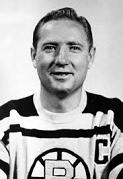
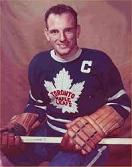
On Oct. 11, 1953 6'0" Detroit Red Wings right wing Gordon "Gordie" "Mr. Hockey" Howe (1928-2016) gets his first Gordie Howe Hat Trick (a goal, an assist, and a fight) in a game with the Toronto Maple Leafs, assisting Red Kelly to score a goal, scoring his own goal, and getting into a fight with 5'10" Leafs defenceman Ferdinand Charles Carl "Fernie" Flaman (1927-2012); he gets his 2nd on Mar. 21, 1954 against the Maple Leafs, assisting Ted Lindsay on two goals, and fighting with 5'11" Leafs center Theodore Samuel "Ted" "Teeder" Kennedy (1925-2009).
On Apr. 4-16, 1954 the 1954 Stanley Cup Finals see the Detroit Red Wings defeat the Montriel Canadians, er, Montreal Canadiens 4-3.



After the 1953-4 season the James Norris Memorial Trophy, named after Detroit Red Wings owner (1932-52) James E. Norris (1879-1952) is established by the NHL for the top "defense player who demonstrates throughout the season the greatest all-round ability in the position"; the first trophy is awarded to Leonard Patrick "Red" Kelly (1927-) of the Detroit Red Wings, who goes on to play on more (8) Stanley Cup winning teams than any other player who never played for the Montreal Canadiens; Douglas Norman "Doug"" Harvey (1924-89) of the Montreal Canadiens wins it in 1955-8, and 1960-1, Bobby Orr wins it in 1968-75, Nicklas Lidstrom wins it in 2001-3, and 2006-8, and Ray Bourque wins it in 1987-8 1990-1, and 1994.
On Apr. 3-14, 1955 the 1955 Stanley Cup Finals see the Detroit Red Wings defeat the Montreal Canadiens 4-3, becoming a 2-peat, starting a title drought that lasts until 1997.
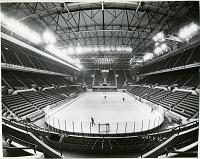
On Oct. 18, 1955 the $2.5M Winnipeg Arena in Manitoba, Canada opens as the home of the WHL Winnipeg Warriors, WCHL Winnipeg Jets, WHA/NHL Winnipeg Jets, AHL Manitoba Moose, and WBL Winnipeg Thunder; it closes on Nov. 7, 2004 after completion of the MTS Centre, and is demolished on Mar. 26, 2006.
On Mar. 31-Apr. 10, 1956 the 1956 Stanley Cup Finals see the Montreal Canadiens defeat the Detroit Red Wings 4-1, becoming the 4th NHL dynasty in 1956-60.
On Apr. 6-16, 1957 the 1957 Stanley Cup Finals see the Montreal Canadiens defeat the Boston Bruins 4-1, becoming their 2nd straight title.

On Jan. 18, 1958 5'10" Fredericton, New Brunswick-born winger Willie Eldon O'Ree (1935-) becomes the first black player in the NHL in a game playing for the Boston Bruins against the Montreal Canadiens; after only playing one more game this season, he plays 43 games in 1961, scoring four goals and 10 assists.
On Apr. 8-20, 1958 the 1958 Stanley Cup Finals see the Montreal Canadiens defeat the Boston Bruins 4-2, becoming a 3-peat (10 total).
On Apr. 9-18, 1959 the 1959 Stanley Cup Finals see the Montreal Canadiens defeat the Toronto Maple Leafs 4-1, becoming a 4-peat.

On Nov. 1, 1959 after being hit in the face by a puck, 6'0" goalie Joseph Jacques Omer "Jake the Snake" Plante (1929-86) of the Montreal Canadiens (NHL) bucks his coach and becomes the first goalie to wear a protective goaltender mask in a game, and after an 18-game winning streak followed by a losing game in which the coach forced him to not wear it, he gets to keep it, starting a trend - plant one on my kisser?

In 1959 the Eastern Prof. Hockey League (EPHL) minor prof. ice hockey league is founded as the NHL's first farm league; in 1963 after poor attendance reduces it to four teams, the Central Professional Hockey League (CPHL) is founded as its successor, with Red Wings gen. mgr. Jack Adams as pres. #1 (until 1968); teams incl. the Indianapolis Capitals (Detroit Red Wings), Minneapolis Bruins (Boston Bruins), Omaha Knights (Montreal Canadiens), St. Louis Braves (Chicago Black Hawks), and St. Paul Rangers (New York Rangers); in Aug. 1968 the league drops the word "Professional" from its title becoming the CHL; in 1964 the Adams Cup is created for the CPHL champion team; the first winner is the Omaha Knights; in 1964 the Tommy Ivan Trophy is created for the league MVP, the Phil Esposito Trophy for the leading scorer, the Bobby Orr Trophy for the most valuable defenseman, and the Ken McKenzie Trophy for rookie of the year; in 1977 the Terry Sawchuck Trophy is created for the top goaltenders, and the Max McNab Trophy for playoffs MVP; in 1978 the Bob Gassoff Trophy is created for the most improved defenseman, the Don Ashby Memorial Trophy for iron man, the Jake Milford Trophy for coach of the year, and the Clarence Campbell Trophy for the team that best exemplifies professionalism in hockey; in 1974 the Denver Spurs, Salt Lake Golden Eagles, and Seattle Totems join from the defunct Western Hockey League (WHL); the league folds in 1984 after the Tulsa Oilers win the Adams Cup.


On Feb. 18-28, 1960 the VIII (8th) Winter Olympic Games are held in Squaw Valley, Calif., becoming the first North Am. Winter Games since 1932; an IBM 305 RAMAC becomes the first computer used in an Olympics; U.S. vice-pres. Richard Nixon opens the games; U.S. figure skater Carol Elizabeth Heiss (1940-) becomes the first woman chosen to recite the Olympic Oath, going on to win a gold medal; South Africa makes its first appearance, and its last until 1994; women's speed skating and men's biathlon debut; the bobsledding event is cancelled as too expensive; artificial refrigeration is first used for speed skating events; David Wilkinson Jenkins (1936-) of the U.S. wins gold for men's figure skating; on Feb. 27 the U.S. Olympic hockey team defeats the Soviet team 3-2 on its way to win the gold medal; the Zamboni ice-resurfacing machine makes its debut, boosting it into internat. prominence, esp. as some connect it with the U.S. hockey win.
On Apr. 7-14, 1960 the 1960 Stanley Cup Finals see the Montreal Canadiens defeat the Toronto Maple Leafs 4-0, becoming a 5-peat, which is not achieved again until ?.
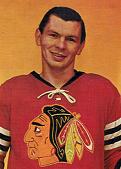
On Apr. 6-16, 1961 the 1961 Stanley Cup Finals see the Chicago Blackhawks (first Finals appearance since 1944) defeat the Detroit Red Wings 4-2, becoming their 3rd title, first since 1938, and last until 2010; the only title won by a team not from Detroit, Toronto, or Montreal during the Original Six Era (1942-67); Czech.-born 5'9" Chicago center Stanislav "Stan" Mikita (Guoth) (1940-) leads the NHL in goals during the playoffs with six, going on next season to become a star, the #1 center of the 1960s, anchoring the Scooter Line with Ken Wharram, Ab McDonald, and Doug Mohns, becoming known for his curved stick along with teammate Bobby Hull, trying his record of 97 points in the 1966-7 season; in 1970 the NHL limits blade curvature to 1/2"; after his daughter Meg asks him why he sits down so much on TV, he cleans up his game.
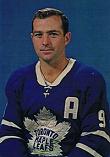
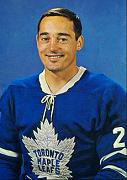
On Apr. 10-22, 1962 the 1962 Stanley Cup Finals see the Toronto Maple Leafs defeat the Chicago Black Hawks 4-2, becoming their first since 1951, becoming the 5th NHL dynasty in 1962-7; 5'10" Leafs left wing (#9) Terrance Richard "Dick" Duff (1936-) scores the series-winning goal; 6'1" Leafs left wing (#2) Francis William "Frank" "Big M" Mahovlich (1938-), who leads the team in goals scored in 1960-1 through 1965-6 is lowballed and walks out of training camp in Sept., and is almost stolen by the Chicago Black Hawks, who accuse the Leafs of reneging on a deal to buy him for $1M, after which fans begin booing him, causing him to suffer from depression, after which he is traded on Mar. 3, 1968 to the Detroit Red Wings, then on Jan. 13, 1971 to the Montreal Canadiens, continuing to set goal-scoring records.
On Apr. 9-18, 1963 the 1963 Stanley Cup Finals see the Toronto Maple Leafs defeat the Detroit Red Wings 4-1, becoming a 2-peat.

In 1964 midway through the 1963-4 season, 6'1" center Philip Anthony "Phil" "Espo" Esposito (1942-) makes his NHL debut with the Chicago Black Hawks, centering for Bobby Hull in the 1964-5 season before being traded to the Boston Bruins for Ken Hodge and Fred Stanfield in 1967, going on to become the top NHL scorer, and the first to score 100 points in a season in 1969 (126 total), and setting a record in the 1970-1 season with 76 goals (152 points), which takes until Feb. 24, 1982 for Wayne Gretzky to pass (79) in a game against the Buffalo Sabres; in 1970 he sets an NHL single season record of 550 shots on goal; fan bumper stickers read "Jesus saves, Esposito scores on the rebound"; he becomes known for the soundbyte: "Scoring is easy. You simply stand in the slot, take your beating and shoot the puck into the net."
On Apr. 11-25, 1964 the 1964 Stanley Cup Finals see the Toronto Maple Leafs defeat the Detroit Red Wings 4-3, becoming their 2nd straight matchup and Toronto's 3rd straight win; the last game 7 at Maple Leaf Gardens until 1993.
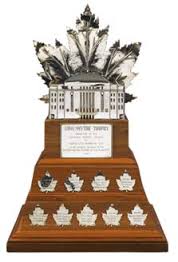

On Apr. 17-May, 1965 the 1965 Stanley Cup Finals see the Montreal Canadiens defeat the Chicago Black Hawks 4-3, becoming the 6th NHL dynasty in 1962-7; the first Conn Smythe Trophy for NHL playoffs MVP, picked by members of the Prof. Hockey Writers' Assoc. (PHWA) is presented to 6'3 center Joseph Jean Arthur "Le Gros Bill" Beliveau (Béliveau) (1931-2014); goalie Patrick Roy becomes the first to win it 3x (each in a different decade); it is never presented to a team that doesn't reach the Finals (until ?).
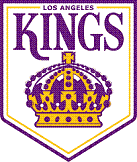
On Feb. 9, 1966 the Los Angeles Kings NHL team is founded in Los Angeles, Calif. by Jack Kent Cooke, playing their home games at The Forum in Inglewood, Calif in 1967-99.

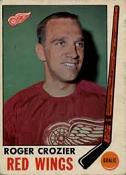
On Mar. 12, 1966 Robert Marvin "Bobby" Hull (1939-), #9 of the Chicago Black Hawks scores his 51st goal against the New York Rangers, setting the NHL single season scoring record; too bad, Wayne Gretzky blows it away in 1981-2 with 92. On Apr. 24-May 5, 1966 the Montreal Canadiens defeat the Detroit Red Wings 4-2 to win the 1966 Stanley Cup Finals, becoming their 7th win in 11 years; MVP is 5'8" Red Wings goalie Roger Allan Crozier (1942-96), becoming the first goaltender to win and the first to win in a losing effort.
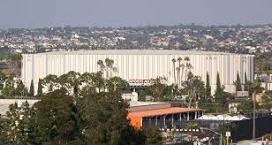
On Nov. 17, 1966 the $6.4M San Diego Sports Arena (originally San Diego Internat. Sports Center, followed in 2004-7 by IPayOne Center, and in 2010 by Valley View Casino Center) in San Diego, Calif. opens as the home of the WHL San Diego Gulls, becoming the #1 U.S. sports facility for 10K-15K seating,

In 1966 18-y.-o. blonde-haired 6'0" hockey defenceman Robert Gordon "Bobby" Orr (1948-) joins the NHL Boston Bruins (until 1976), helping them win eight straight playoffs and two Stanley Cups.


In 1966 the Western Hockey League (WHL) (originally Canadian Major Junior Hockey League until 1967, then Western Canadian Hockey League until 1978) major junior (ages 16-20) ice hockey league is founded by seven teams in Sask. and Alberta, establishing the Ed Chynoweth Cup, whose winner moves on to play for the Memorial Cup; by 2015 there are 17 W Canadian teams and five NW U.S. teams.
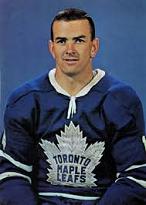
On Apr. 20-May 2, 1967 the 1967 Stanley Cup Finals see the Toronto Maple Leafs defeat the Montreal Canadiens 4-2, becoming their 13th title, beginning a drought, not playing in a Finals again until ?; starting next season the expansion teams become the Western Div., ensuring that one of them goes to the finals; MVP is 5'9" Leafs center David Michael "Dave" Keon (1940-), who shuts down Montreal star center Jean Beliveau in the last two games, becoming the first Leaf to win MVP (until ?); his eight points become the fewest by a non-goalie MVP (until ?).

In June 1967 after an attempt to form it in 1957 by players Ted Lindsay of the Detroit Red Wings and Doug Harvey of the Montreal Canadiens is quashed by the owners, the Nat. Hockey League (NHL) Players' Assoc. is founded under threat of intervention by the Canadian Labour Relations Board, with Toronto Maple Leafs player Robert Jesse "Bob" Pulford (1936-) as pres. #1.
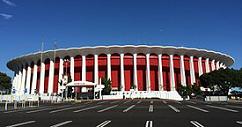
On Dec. 30, 1967 the circular $16M The (Fabulous) (L.A.) Forum multipurpose indoor arena in Inglewood, Calif. (3 mi. E of Los Angeles Internat. Airport) opens, becoming the West Coast equal to New York City's Madison Square Garden, and home to the NBA Los Angeles Lakers and NHL Los Angeles Kings; in Dec. 1988 it becomes the Great Western Forum.
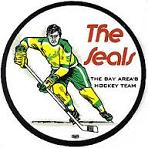

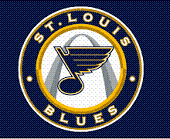
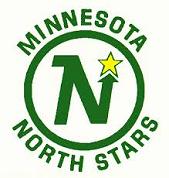
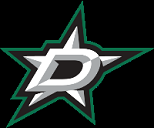
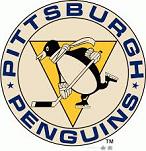
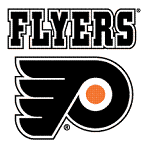
In 1967 the 1967 NHL Expansion sees six new teams added to the NHL, giving it 12 teams; new teams incl. the Calif. Golden Seals (until 1976), the Los Angeles Kings (founded Feb. 9, 1966), the St. Louis Blues (last new team, chosen over Baltimore at the insistence of the Chicago Blackhawks), becoming the oldest team to never win the Stanley Cup), the Minn. North Stars (Dallas Stars in 1993), and the rival Pittsburgh Penguins and Philadelphia Flyers in Penn.; the Flyers win Stanley Cups in 1974 and 1975, and the Penguins in 1991, 1992, and 2009.

On May 5-11, 1968 the 1968 Stanley Cup Finals see the Montreal Canadiens defeat the St. Louis Blues 4-0; each game is decided by one goal.; MVP is 5'11" Blues goalie Glenn Henry "Mr. Goalie" Hall (1931-), inventor of the butterfly style of goalkeeping.
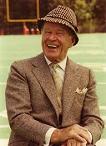
On Jan. 1, 1969 Jack Kent Cooke (1912-97), owner of the Los Angeles Kings (NHL) fines his players $100 for not arguing with the referee. On Apr. 27-May 4 the 1969 Stanley Cup Finals see the defending champion Montreal Canadiens defeat the St. Louis Blues 4-0.

On May 3-10, 1970 the 1970 Stanley Cup Finals see the Boston Bruins defeat the St. Louis Blues 4-0, becoming their first win since 1941; despite being tripped by Noel Picard of the Blues, 6'0" Bruins defenceman (MVP) Robert Gordon "Bobby" Orr (1948-) scores an OT goal on Glenn Hall with an assist from Derek Sanderson at 00:00.40 to win the series; a photo of Orr flying through the air with arms raised in victory becomes the most famous hockey image of all time (until ?).
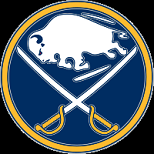
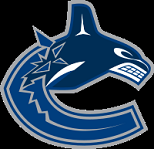

In 1970 the NHL expands from 12 to 14 teams; the Buffalo Sabres NHL team is founded in Buffalo, N.Y., playing their home games in Buffalo Memorial Auditorium; the Vancouver Canucks NHL team is founded in Vancouver, B.C., Canada, playing their home games at the $6M Pacific Coliseum (AKA the Rink on Renfrew) (opened Jan. 8, 1968).

On May 4-18, 1971 the 1971 Stanley Cup Finals see the Montreal Canadiens defeat the Chicago Black Hawks 4-3; MVP is 6'4" Montreal goalie Kenneth Wayne "Ken" Dryden (1947-), who goes on to become a Liberal MP in 2004-11.
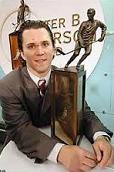
After the 1970-1 season, the Lester B. Pearson Award, named after the Canadian PM (1963-8), who coached the U. of Toronto Varsity Blues men's ice hockey team is established by the NHL for the MVP as judged by the players; first winner is Phil Esposito of the Boston Bruins; Wayne Gretzky of the Edmonton Oilers wins it 5x in 1982-5 and 1987; on Apr. 29, 2010 it is renamed the Ted Lindsay Award after Detroit Red Wings player Ted Lindsay.
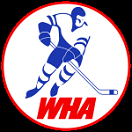

On Sept. 13, 1971 the 12-team World Hockey Assoc. (WHA) is founded to compete with the NHL, becoming their first major competitor since the Western Hockey League in 1926, attracting players by offering higher salaries and challenging the NHL's reserve clause, causing 67 players to jump in the first year, led by Bobby Hull, who signs a record 10-year $2.75M contract with the Winnipeg Jets; teams incl. the Alberta/Edmonton Oilers (1972-9), Chicago Cougars (1972-5), Cincinnati Stingers (1975-9), Calgary Broncos/Cleveland Crusaders/Minnesota Fighting Saints (1972-7), Denver Spurs/Ottawa Civics (1975-6), Dayton Arrows/Houston Aeros (1972-8), Indianapolis Racers (1974-8), Los Angeles Sharks/Michigan Stags/Baltimore Blades (1972-4), New England/Hartford Whalers (1972-9), New York Raiders/New York Golden Blades/Jersey Knights/Seattle Mariners (1972-7), Ottawa Nationals/Toronto Toros/Birmingham Bulls (1972-9), Miami Screaming Eagles/Philadelphia Blazers/Vancouver Blazers/Calgary Cowboys (1972-7), Phoenix Roadrunners (1974-7), San Francisco Sharks/Quebec Nordiques (1972-9), and Winnipeg Jets (1972-9); in 1972 the WHA establishes the Avco Cup (World Trophy) after a $500K donation by AVCO Financial Services Corp., becoming the first major sports league trophy bearing the name of a private corp.; it has a floating etched crystal globe in the stem; the last WHA game is played on May 20, 1979, with the Winnipeg Jets led by Bobby Hull defeating the Edmonton Oilers led by Wayne Gretzky, winning their 3rd cup; Gordie Howe and the Houston Aeros win the cup twice.
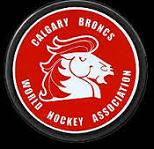

On Nov. 1, 1971 the Calgary Broncos World Hockey Assoc. (WHA) team is founded in Calgary, Alberta, Canada, moving to Ohio as the Cleveland Crusaders, which in 1976 after the California Golden Seals move to Cleveland move to St. Paul, Minn. as the New Minnesota Fighting Saints (with an identical logo except for red britches and gloves), folding after winning their last game on Jan. 14, 1977 9-5 over the Indianapolis Racers at home.
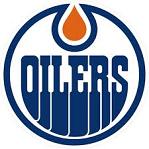
On Nov. 1, 1971 the Edmonton Oilers (originally Alberta Oilers) World Hockey Assoc. (WHA) team is founded in Edmonton, Alberta, Canada, joining the NHL in 1979, founding a dynasty that wins the Stanlay Cup in 1984, 1985, 197, 1988, and 1990.
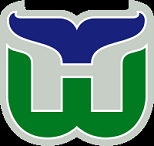
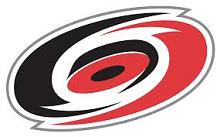
On Nov. 1, 1971 the New England Whalers World Hockey Assoc. (WHA) team is founded in Boston, Mass., playing their home games in the Boston Arena and the Boston Garden, moving to Hartford, Conn. for the 1974-5 season, playing their home games at the Big E Coliseum in West Springfield, Mass. before playing their first game on Jan. 11, 1975 at the Hartford Civic Center Coliseum; in 1979 after the WHA-NHL merger, they become the Hartford Whalers; after the 1996-7 season they move to Research Triangle, N.C., becoming the Carolina Hurricanes, leaving Conn. with no major sports team.
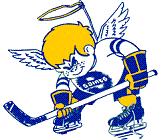
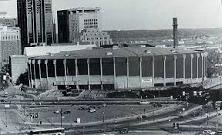
On Nov. 1, 1971 the Minnesota Fighting Saints World Hockey Assoc. (WHA) team is founded in St. Paul, Minn., playing their home games at the new St. Paul Civic Center (cap. 16K) (opened Jan. 1, 1973) (RiverCentre in 1995), tying their first game 4-4 in OT against the Houston Aeros; bucking the trend, they feature mostly Minn.-born or U.S.-born players, drawing larger WHA crowds than average but never securing a TV deal, playing their last game on Feb. 25, 1976, losing 2-1 in OT to the San Diego Mariners.
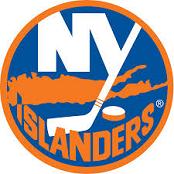

On Nov. 8, 1971 over the objections of the New York Rangers, the New York Islanders (AKA the Isles) NHL team is founded in New York City, playing their home games in the Nassau Veterans Memorial Coliseum; on Oct. 12, 1972 they score their first win in a 3-2 game against the Los Angeles Kings, finishing last with a NHL low 12-60-6 record despite a 9-7 win over the champion Boston Bruins on Jan. 18; starting in their 3rd season (1974) after drafting 6'0" defenceman Denis Charles Potvin (1953-) (#5) in 1973, they secure 14 straight playoff berths starting in 1974, and 19 straight playoff wins in 1980-4, winning four straight Stanley Cups in 1980-3, becoming a dynasty.
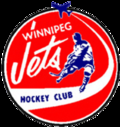
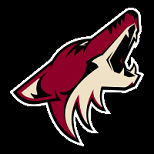
On Dec. 27, 1971 the Winnipeg Jets of the World Hockey Assoc. (WHA) are founded, playing their home games in the Winnipeg Arena; on July 1, 1996 after financial problems they move to Phoenix, Ariz. as the NHL Phoenix (Arizona) Coyotes, playing at the America West Arena; in 2011 the Atlanta Thrashers move to Winnipeg and become the Winnipeg Jets.

In 1971 6'0" "Quebec-born right wing Guy Damien "The Flower" "Le Demon Blond" Lafleur (1951-) is drafted #1 overall by the Montreal Canadiens, going on to become the first NHL player to score 50 goals and 100 points in six straight seasons, winning five Stanley Cups in 17 seasons.

On Feb. 11, 1972 $32M Nassau Veterans Memorial Coliseum in Uniondale, Long Island, N.Y., 30 km (19 mi.) from New York City opens as the home of the NHL New York Islanders (until Aug. 5, 2015).
On Apr. 30-May 11, 1972 the 1972 Stanley Cup Finals (their 2nd Finals match since 1929) see the Boston Bruins defeat the New York Rangers (first Finals appearance since 1970) 4-2; MVP is Bobby Orr.


In the 1972-3 season the Philadelphia Flyers earn the nickname "the Broad Street Bullies"; coach Frederick Alexander "Fred" "the Fog" Shero (1925-90) tells the press that he coaches them to "take the shortest route to the puck carrier and arrive in ill humor", with top enforcers incl. David William "Dave" "the Hammer" "Grouch" Schultz (1949-) (NHL record 472 penalty min. in a single season), Robert James "Bob" "Hound Dog" Kelly (1950-), Donald Patrick "Don" "Big Bird" Saleski (1949-), and Andre "Moose" Dupont (1949-), and top skill players incl. Robert Earle "Bob" Bobby" Clarke (1949-) (2-way forward) (3-time NHL MVP) , Reginald Joseph "Reggie" Leach (1950-), Orest Michael "Oscar' "Ernie" Kindrachuk (1950-), and William Charles "Bill" Barber (1952-); Saleski (Big Bird), Dave Schultz (Grouch), and Orest Kindrachuck (Oscar or Ernie) are also called the "Sesame Street Line".
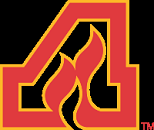
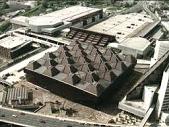
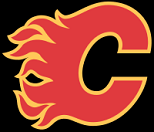
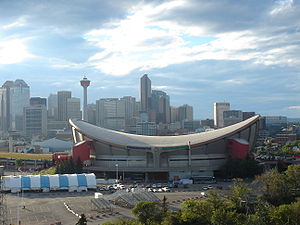
On Oct. 14, 1972 the $17M Omni Coliseum in Atlanta, Ga. opens as the home of the NBA Atlanta Hawks and the new NHL Atlanta Flames, which in 1980 after only two post-season wins moves to Calgary, Alberta, Canada, becoming the Calgary Flames, playing their home games at the $97M Olympic Saddledome (opened Oct. 15, 1983) (Canadian Airlines Saddledome in 1995, Pengrowth Saddledome in 2000, and Scotiabank Saddledome in 2010), and getting into the rivalry known as the Battle of Alberta with the Edmonton Oilers.
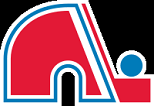
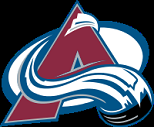
In 1972 the Quebec Nordiques of the World Hockey Assoc. (WHA) are founded in Quebec City, joining the NHL in 1979 as part of the NHL-WHA merger; after the 1994-95 season they move to Denver, Colo., becoming the Colorado Avalanche.


On Apr. 29-May 10, 1973 after the semifinal game sees the Philadelphia Flyers win the opening game in Montreal when center Rick MacLeish intercepts an errant pass by Frank Mahovlich that allegedly got lost in a "puddle of war", scoring in OT, then losing the series 4-1, the 1973 Stanley Cup Finals, a rematch of the 1971 championship series see the Montreal Canadiens defeat the Chicago Black Hawks 4-2; MVP is 5'7" Montreal right wing Yvan Serge "the Roadrunner" Cournoyer (1943), known for using longer blades on his skates to give him blazing speed despite his small size. Flyers goalie Bernard Marcel "Bernie" Parent (1945-) plays one of the finest seasons by a goaltender ever, and repeats next year, winning the Vezina Trophy and Conn Smythe Trophy both seasons.
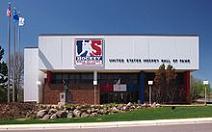
In 1973 the U.S. Hockey Hall of Fame is founded at 801 Hat Trick Ave. in Eveleth, Minn.
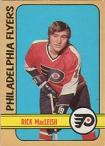
On May 7-19, 1974 the 1974 Stanley Cup Finals see the "Broad Street Bullies" Philadelphia Flyers (first NHL team to use intimidation as a tactic) defeat the Boston Bruins 4-2, becoming the first 1967 NHL expansion team to win; MVP is 5'11" Flyers center Richard George "Rick" MacLeish (1950-), who scores the one and only goal in the final game; after the 1973-74 season the Jack Adams Award, named for Detroit Red Wings coach (1927-63) John James "Trader Jack" Adams (1895-1968) is established by the NHL for the coach "adjudged to have contributed the most to his team's success" as judged by the NHL Broadcasters Assoc.; the first award goes to Fred Shero of the Philadelphia Flyers.

On Nov. 10, 1974 the $17M Northlands Coliseum in Edmonton, Alberta, Cana opens as the home of the NHL Edmonton Oilers; it becomes the Edmonton Coliseum in 1994, Skyreach Centre in 1998, and Rexall Place in 2003.


In 1974 the NHL Kansas City Scouts are founded in Kansas City, Mo., moving to Denver Colo. in 1976 and becoming the Colorado Rockies; in 1982 they relocate to East Rutherford, N.J. as the New Jersey Devils; after only making the playoffs once in 13 seasons, they hire gen. mgr. Louis A. "Lou" Lamoriello (1942-), after which they go on to do it in 20 of the next 22 seasons incl. 13 in a row in 1997-2010, achieving a winning record every season from 1992-3 to 2009-10, winning the Stanley Cup in 1995, 2000, and 2003; in 2007 they relocate to the Prudential Center in Newark, N.J.
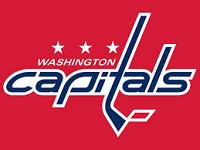

In 1974 the Washington Capitals NHL team is founded, playing their home games at the new $18M Capital Centre (USAir Arena in 1993) in Landover, Md. (opened Dec. 2, 1973) until 1997.
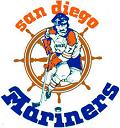
In 1974 the San Diego Mariners World Hockey Assoc. (WHA) team is founded from the Jersey Knights (New York Golden Blades) (New York Raiders), playing their home games at the San Diego Sports Arena; too bad, with only 5K fans per game, owner Ray Kroc sells them in 1977, after which they fold in the fall before the start of the 1977-8 season.
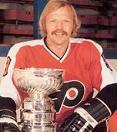

On May 15-27, 1975 the 1975 Stanley Cup Finals (first with two expansion teams) see the "Bullies of Broad Street" Philadelphia Flyers defeat the Buffalo Sabres 4-2, becoming the last championship team composed solely of Canadian-born players; the only Finals between 1965-79 without the Boston Bruins or Montreal Canadiens; the series-winning goal is scored by 5'10" Flyers left wing Robert James "Bob" "Hound" "Houndog" Kelly (1950-); MVP is 5'10" Flyers goalie Bernard Marcel "Bernie" Parent (1945-).
In 1975 the Canadian (Major Junior) Hockey League (CHL) is founded for players age 16-20, with three leagues incl. the Western Hockey League, Ontario Hockey League, and Quebec Major Junior Hockey League comprising 60 teams in nine Canadian provinces and four U.S. states.

On Jan. 11, 1976 the "Bullies of Broad St." Philadelphia Flyers of the NHL play the Soviet Red Army hockey team, and win 4-1 after the Soviets leave the ice for part of the game. On May 9-16, 1976 the 1976 Stanley Cup Finals see the Montreal Canadiens defeat the Philadelphia Flyers 4-0, becoming the 7th NHL dynasty in 1976-9; Flyers player Reginald Joseph "Reggie" Leach (1950-) wins MVP despite being on the losing team after scoring a record 19 goals, incl. a 5-goal game against the Boston Bruins, and 80 goals for the season and playoffs, becoming the first non-goaltender.

On Feb. 27, 1977 George Roy Hill's Slap Shot debuts, written by Nancy Dowd based on real-life experiences of her brother Ned, starring Paul Newman as hockey coach Reggie "Reg" Dunlop, whose loser Charleston Chiefs team is being written off by its cynical owner until he hires the "goon" Hanson brothers (Steve Carlson, Jeff Carlson, David Hanson), who win by dirty tricks and near-homicidal bullying, playing to the adoring crowds, who come to see blood; Michael Ontkean (who turned a real contract down from the New York Rangers) plays lone quality player (Princeton grad) Ned Braden; Jerry Houser plays Dave "Killer" Carlson; Strother Martin plays mgr. Strother Martin; Paul D'Amato plays mean Tim "Dr. Hook" McCracken, who's "been known to carve a man's eye out with a flick of the wrist"; former pro hockey player Ned Dowd (a future film producer) plays rookie goon Ogie Oglethorpe, based on real-life player Bill "Harpo" Goldthorpe; the best hockey flick ever made?; "Dunlop, you suck cock"; "All I can get."

On May 7-14, 1977 the 1977 Stanley Cup Finals see the Montreal Canadiens defeat the Boston Ruins, er, Bruins 4-0, becoming a 2-peat; MVP is 6'0" Montreal right wing Guy Damien "The Flower" "Le Demon Blond" Lafleur (1951-).

On Dec. 7, 1977 49-y.-o. Gordon "Gordie" Howe (1928-2016) of the New England Whalers becomes the first player in the NHL to score 1K career hockey goals in 1:36 of period 1 against goalie John Garrett of the Birmingham Bulls.
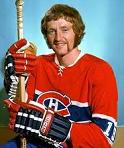
On May 13-25, 1978 the 1978 Stanley Cup Finals see the Montreal Canadiens defeat the Boston Bruins 4-2, becoming a 3-peat; MVP is 6'4" "Montreal defenceman Larry Clark "Big Bird" Robinson (1951-).
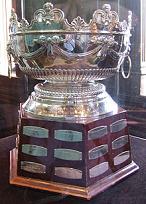

After the 1977-78 season the Frank J. Selke Trophy, named after Toronto Maple Leafs and Montreal Canadiens gen. mgr. Francis Joseph Aloysius "Frank" Selke (1893-1985) is established by the NHL for the forward who demonstrates the most defensive skill as selected by the Prof. Hockey Writers' Assoc.; the first award goes to Bob Gainey of the Montreal Canadiens, who goes on to 4-peat.

On May 13-21, 1979 the 1979 Stanley Cup Finals see the Montreal Canadiens defeat the New York Rangers (first Finals appearance since 1972) 4-1, becoming a 4-peat; they don't compete in another Finals until 2013; the 1979 NHL-WHA Merger results in the Edmonton Oilers, New England Whalers, Quebec Nordiques, and Winnipeg Jets joining the NHL for the 1979-80 season; MVP is 6'2" Montreal left wing Robert Michael "Bob" "Le Capitaine" Gainey (1953-), known for his shut-down defensive style.

On Nov. 28, 1979 5'10" "Islanders goalie William John "Battlin' Billy" Smith (1950-) becomes the first NHL goaltender to score a goal in a game against the Colorado Rockies when a puck deflects off his chest protector and Colorado rookie Rob Ramage accidentally passes it into his own net.

On Dec. 12, 1979 the $57M 20,058-seat Joe Louis Arena in Detroit, Mich. (where he grew up) opens as the home of the NHL Detroit Red Wings (until ?).


On Feb. 13-24, 1980 the XIII (13th) Winter Olympics are held in Lake Placid, N.Y. (first time 1932); on Feb. 22 the Miracle on Ice sees a stunning semifinal round 4-3 upset by the U.S. Olympic hockey team, coached by Herbert Paul "Herb" Brooks (1937-2003) over the Soviets, after which they go on to win the gold on Feb. 24 by defeating Finland 4-2.

On Apr. 28, 1980 $27M Reunion Arena in Dallas, Tex. opens as the home of the NBA Dallas Mavericks (cap. 18,187) and NHL Dallas Stars (cap. 17,001); it closes on June 30, 2008.

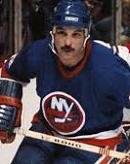
On May 13-24, 1980 the 1980 Stanley Cup Finals see the New York Islanders (first Finals appearance) defeat the Philadelphia Flyers (first Finals appearance since 1976) 4-2; first of four straight titles, becoming the 8th NHL dynasty in 1980-3; the winning goal is in 7:11 of OT by 6'1" Swedish-born Canadian right-winger Robert Thore "Bob" "Bobby" Nystrom (1952-); MVP is 5'11" Islanders center Bryan John Trottier (1956-), who set an NHL record of six points in a single period (four goals, two assists) in the 2nd period of a game against the Rangers on Dec. 23, 1978.

On Dec. 27, 1980 5'11" Hartford Whalers left winger Mark Steven Howe (1955-) (son of Gordie Howe) slides into the pointed metal center of the net and cuts a 5-in. gash in his thigh, causing the NFL to change the design; after the Hartford Whalers trade him to the Philadelphia Flyers, he anchors one of the best defensive NHL teams of the mid-1980s, which finishes the 1984-5 season with the most points, losing the Stanley Cup Finals to the Edmonton Oilers, then scoring 82 points in the 1985-6 season.
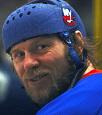
On May 12-21, 1981 the 1981 Stanley Cup Finals see the New York Islanders (2nd Finals apperance) defeat the Minn. North Stars (first Finals appearance) 4-1; last all-U.S. Finals until 1991; MVP is 5'10" Islanders center Robert Thomas "Butch"" Goring (1949-).
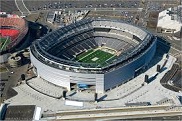
On July 2, 1981 the $85M Meadowlands Arena in East Rutherford, N.J. opens as the home of the New York Nets NBA team and the New Jersey Devils (formerly the Colo. Rockies) NHL team; it closes on Apr. 3, 2015 - with Jimmy Hoffa buried in one of its concrete pillars?


In 1982 after scoring his record 77th goal on Feb. 24, Edmonton Oilers center (1979-88) Wayne Douglas Gretzky (1961-) sets an NHL record with 92 goals in one season, plus a record 61 goals in the first 50 games; in the 1983-4 season he gets a record 100 goals in the regular season plus the playoffs, and another 61 goals in the first 50 games.
On May 8-16, 1982 the 1982 Stanley Cup Finals see the New York Islands sweep the Vancouver Canucks (first Finals appearance, and first team from W Canada since 1926) 4-0, becoming their 3-peat, becoming the last U.S.-based team until ?; MVP is Mike Bossy of the Islanders.


On Apr. 1, 1983 N.Y. Islanders right winger (1977-87) Michael Dean "Mike" Bossy (1957-) becomes the first NHL player to score 60 goals in three consecutive seasons. On May 10-17, 1983 the 1983 Stanley Cup Finals see the New York Islanders (4th straight Finals appearance) sweep the Edmonton Oilers (first Finals appearance) 4-0, becoming their 4-peat, the first since the Montreal Canadiens in 1976-9; the Oilers score only five goals in four games, and Wayne Gretzky goes scoreless; MVP is 5'10" "Islanders goalie William John "Battlin' Billy"" Smith (1950-); "As far as I'm concerned, we're the best hockey team ever to lace on skates" (Islanders team captain Denis Potvin).

On June 8, 1983 Brian R. Lawton (1965-) becomes the first-overall draft pick by the Minn. North Stars, becoming the first h.s. hockey player to be drafted first-overall; too bad, he turns out to be a bust, starting out by having to trade his jersey #98 for #8 after grumbles about comparing himself to #99 Wayne Gretzky.
On May 10-19, 1984 the 1984 Stanley Cup Finals see the Edmonton Oilers defeat the New York Islanders 4-1, revenging last year's defeat, becoming the 9th NHL dynasty in 1984-90; the last time that the same two teams meet in consecutive finals until 2009; MVP is Mark Messier.

On June 9, 1984 6'4" Montreal-born center ("the Magnificent One") Mario Lemieux (1965-) is drafted #1 by the Pittsburgh Penguins (#66), saving them and leading them to two straight Stanley Cups in 1991 and 1992, retiring in 2006 and returning as owner, after which they win their 3rd cup in 2009.
On May 21-30, 1985 the 1985 Stanley Cup Finals see the defending champion Edmonton Oilers (3rd straight Finals appearance) defeat the Philadelphia Flyers 4-1, becoming their 2nd win; MVP is Wayne Gretzky.

On May 16-24, 1986 the 1986 Stanley Cup Finals (first all-Canadian Finals since 1967) see the Montreal Canadiens defeat the Calgary Flames (first appearance) 4-1, becoming their 17th win in their last 18 Finals appearances since 1956; MVP is Canadiens rookie goalie "Saint" Patrick Jacques Roy (1965-) (pr. "wah").
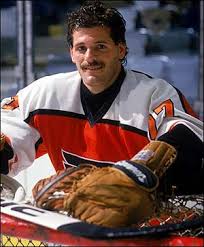
On May 17-31, 1987 the 1987 Stanley Cup Finals see the Edmonton Oilers defeat the Philadelphia Flyers 4-3; MVP is 6'3" Flyers goalie Ronald Jeffrey "Ron" Hextall (1964-).
On May 18-26, 1988 the 1988 Stanley Cup Finals see the Edmonton Oilers defeat the Boston Bruins 4-0; MVP is Oilers center Wayne Gretzky, who on Aug. 9 is traded to the Los Angeles Kings; MVP is Al MacInnis.

On May 14-25, 1989 the 1989 Stanley Cup Finals see the Calgary Flames defeat the Montreal Canadiens 4-2, becoming the last time the final series is played entirely in Canada (until ?); the Flames become the first relocated NHL team (from Atlanta, Ga. in 1980-1) to win the title; MVP is 6'1" Flames defenceman Allan "Al" MacInnis (1963-), known for having the hardest shot in the NHL, once splitting Mike Liut's mask with a shot.
On Oct. 15, 1989 Wayne Gretzky of the Los Angeles Kings surpasses Gordie Howe's NHL scoring record of 1,850 points in a game against his former team the Edmonton Oilers after a puck bounces off the leg of teammate Dave Taylor and he flicks it past Edmonton goalie Bill Ranford, tying the game; on Dec. 29 Gretzky and tennis star Martina Navratilova are named athletes of the decade by the Associated Press (AP).

In 1989 goalie Vladislav Tretiak (1952-) becomes the first Soviet (Russian) hockey player inducted to the Hockey Hall of Fame, even though he never played for the NHL; in 2000 he is voted best Russian hockey player of the cent.

On May 15-24, 1990 the 1990 Stanley Cup Finals see the Edmonton Oilers defeat the Boston Bruins 4-1, becoming the last of eight straight Finals with a team from Alberta (Oilers 6x, Flames 2x); MVP is Oilers goaltender William Edward "Bill" Ranford (1966-).

On June 16, 1990 Kladno, Czech.-born Jaromir Jagr (1972-) is selected #5 overall by the Pittsburgh Penguins, going on to win two straight Stanley Cups in 1991-2 and become the most productive Euro player in NHL history.
On Oct. 26, 1990 Wayne Gretzky of the Los Angles Kings becomes the first NHL player to reach 2,000 career points after scoring an assist against the Winnipeg Jets by passing the puck to Tony Granato, who passes it to Tomas Sandstrom, who beats Jets goalie Bob Essena at 14:32 into the first period; the Jets win 6-2 after Gretzky fails to score a goal; on Jan. 3, 1991 Gretzky scores his 700th goal (4th NHL player) in a game against the New York Islanders, going on to score 5+ goals in four games in the season and score an NHL record 93rd playoff goal on Apr. 10.
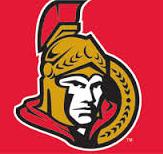
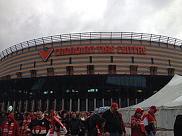

On Dec. 6, 1990 the new Ottawa Senators NHL team is founded in Ottawa, Ont., Canada by real estate developer Bruce Firestone (1951-), playing its first games in the 1992-3 season, later playing their home games at the Canadian Tire Center, which opens on Jan. 15, 1996.
On May 15-25, 1991 the 1991 Stanley Cup Finals (first all-U.S. Finals since 1981) see the Pittsburgh Steelers (first Finals appearance) defeat the Minn. North Stars (first Finals appearance) 4-2, becoming their first win, and the first U.S. franchise to win since 1983, also the first Finals since 1982 not featuring the Calgary Flames or Edmonton Oilers, and the first since 1981 with no team from W Canada; the first Finals not extending into June; MVP is Mario Lemieux.

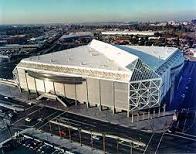
In 1991 the San Jose Sharks NHL team is founded in San Jose, Calif., playing their home games at the $162.5M San Jose Arena AKA the Shark Tank (opened Sept. 7, 1993); in 2001 it becomes the Compac Center; in 2002 it becomes HP Pavillion; in June 2013 it becomes SAP Center.
On May 26-June 1, 1992 the 1992 Stanley Cup Finals see the Pittsburgh Penguins sweep the Chicago Blackhawks (first Finals appearance since 1973) 4-0 after the Blackhawks start out leading the Penguins 4-1 in game 1, becoming their 2nd straight win; MVP is Mario Lemieux; last Finals played in Chicago Stadium, which closes in 1994.
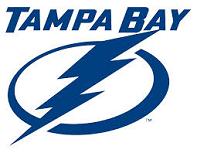
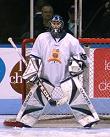

On Oct. 7, 1992 after 5'7" goaltender Manon Rheaume (Rhéaume) (1972-) becomes the first woman to play in an NHL game during the preseason, the Tampa Bay Lightning (Bolts) play their first game in Expo Hall at the Fla. State Fairgrounds in Tampa, Fla., defeating the Chicago Blackhawks 7-3 incl. four goals by 6'1" wing Christopher T. "Chris" Kontos (1963-).
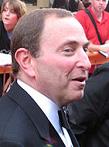
On Feb. 1, 1993 Queens, N.Y.-born atty. Gary Bruce Bettman (1952-) becomes NHL commissioner (until ?), going on to add six new teams to bring the total to 30 while increasing league revenues from $400M to $3B in 2010-11; too bad, expanding the league into the Am. South and being responsible for three labor stoppages makes him unpopular with fans.
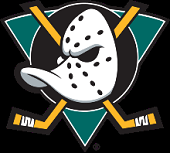
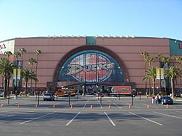
On Mar. 1, 1993 the Anaheim Ducks NHL team in Anaheim, Calif. is founded by Walt Disney Co., named after their 1992 film "The Mighty Ducks", playing their home games in the new $123M Anaheim Arena (AKA The Pond) E of Disneyland (opened June 19, 1993); in Oct. 1993 it becomes Arrowhead Pond of Anaheim; in Oct. 2006 it becomes Honda (Ponda) Center.


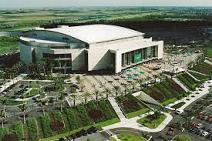
On Apr. 20, 1993 the Florida Panthers NHL team is founded in Sunrise, Fla. by Blockbuster Video magnate Harry Wayne Huizenga (1937-), starting play in the 1993-4 season, playing home games at the Miami Arena, followed by the new $185M Broward County Civic Arena (opened Oct. 3, 1998) (National Car Rental Center in July 1998, BB&T Center in July 2012).
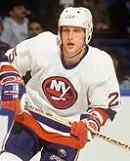
On May 14, 1993 the 1993 Islanders Miracle sees the longtime hapless New York Islanders after surpassing 80 points per season for the first time in six years upset the 2-time defending champion Pittsburgh Penguins (coming off 119 regular season points and a record 17 straight wins at the end of the season) 4-3 at 5:16 of OT of game 7 of round 2 of the playoffs with a goal by 6'0" "Prague, Czech.-born winger David Volek (1966-), winning the series 4-3, after which they are defeated 3-2 by the Montreal Canadiens, becoming the last playoff series won by the Islanders until ?.

On June 1-9, 1993 (100th anniv. of the Stanley Cup) the 1993 Stanley Cup Finals see the Montreal Canadiens defeat the Los Angeles Kings 4-1; MVP is "St." Patrick Jacques Roy (1965-) (pr. "WAH") ; the Canadiens become the last team to win the Cup, and the last championship team composed solely of North Am.-born players.





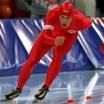

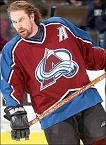
Lipstick jungle on ice? On Jan. 6, 1994 Cinderella-like Olympic figure skater Nancy Kerrigan (1969-) of Stoneham, Mass. is attacked and her knee whacked by a collapsible metal baton; the attack is later traced to the husband and three associates of her skating rival, trailer park-raised (trailer trash? who said trailer trash?) Tonya Harding (1970-) of Portland, Ore., but she plays the plausible deniability game and is allowed to compete in the XVII (17th) Winter Olympics in Lillehammer, Norway on Feb. 12-27 (mascots are the folk-character kids Haakon and Kristin), which are made into a media circus by their scrap; even though Kerrigan skates nearly perfectly just 50 days after her clubbing (winning a silver on Feb. 25), and Harding falls apart, coming in 8th and leaving a photo opp of her moping face, independent Ukraine receives its first Olympic gold medal for dark horse Orphan Annie almost-too-young figure skater Oksana Baiul (1977-); the Winter Olympics are moved to a 2-year offset from the Summer Olympics starting this year for marketing purposes; crystal-clear Norwegian opera soprano Sissel Kyrkjebo (1969-) performs during the opening and closing ceremonies; 29-y.-o. Bonnie Kathleen Blair (1964-) of the U.S. wins two gold medals for the 500m and 1000m speed-skating events, giving her five career golds, the most ever by a U.S. woman in Winter or Summer Olympics; Daniel Erwin "Dan" Jansen (1965-) of the U.S. wins a gold in the 1000m speed-skating event; Johann Olav Koss (1968-) of Norway wins three speed skating golds (1500m, 5K, 10K), and sets three world records; after Cathy Ann Turner (1962-) of Hilton, N.Y. wins the 500m short-track speed skating gold for her 2nd consecutive Olympics, silver medalist Zhang Yanmei (1972-) of China accuses her of grabbing her leg during the race, then stalks off the ceremonial stand, takes her medal off, and flings her flower bouquet to the ground; the men's ice hockey gold is won by Sweden, followed by Canada and Finland; Peter Mattias "Foppa" Forsberg (1973) helps Sweden win, winning another gold at the 2006 Winter Olympics, which combined with two Stanley Cups with the Colorado Avalanche and the 1992 and 1998 world championships makes him a member of the Triple Gold Club, and the only Swede to win each of the three competitions twice; Norway leads in total medal standings with 10 golds and 26 total, Germany is 2nd with 9 golds and 24 total, and Russia is 3rd with 11 golds and 23 total; the U.S. is 5th with 6 golds and 13 total.
On Mar. 20, 1994 Wayne Gretzky of the Los Angeles Kings ties Gordie Howe's career goals record of 802 against the San Jose Sharks at San Jose, Calif. Arena, going on to reach 894 before retiring in 1999.

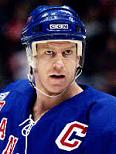
On May 31-June 14, 1994 the 1994 Stanley Cup Finals see the New York Rangers defeat the Vancouver Canucks 4-3; center Mark Douglas Messier (1961-) leads the Rangers to their first Stanley Cup in 54 years, earning him the nickname "The Messiah"; CBC Sports broadcasts Game 7, attracting a record 4.957M viewers; MVP is 6'0" Corpus Christi, Tex.-born Rangers defenceman Brian Joseph Leetch (1968-), who becomes the first non-Canadian MVP.
On Oct. 1, 1994 NHL team owners lock out the players despite assurances that they would not strike in the coming season; on Jan. 11, 1995 the owners' Oct. 1994 lockout is ended, and the 1994-5 NHL season is salvaged, to begin on Jan. 20, with a 48-game rather than 84-game schedule.

On June 17-24, 1995 after a short season caused by an owners' lockout, the 1995 Stanley Cup Finals see the underdog New Jersey Devils (first Finals appearance) sweep the Detroit Red Wings (first Finals appearance since 1966) 4-0, becoming their first win, and the first of nine Stanley Cups won by either the Devils, Red Wings, or Colorado Avalanche in nine seasons (1995-2003) in a repeating cycle (Devils, Avalanche, Red Wings); the first of nine straight Finals contested by U.S.-based franchises exclusively; MVP is 6'0" Devils right wing Claude Percy Lemieux (1965-) (no relation to Mario Lemieux), who is traded to the Colorado Avalanche, becoming the 10th NHL player to win back-to-back Stanley Cups with different teams.

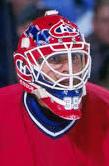
On Dec. 6, 1995 after being humiliated on Dec. 2 in a 11-1 loss to the Detroit Red Wings by coach Mario Tremblay, allowing nine goals on 26 shots (incl. five goals on 17 shots in the 1st period) before finally being pulled in the middle of the 2nd period in favor of Patrick David "Pat" Jablonski (1967-), pissing him off and causing him to tell team pres. Ronald Corey that this is his last game, then being suspended on Dec. 3, Montreal Canadiens goalie (#33) "St." Patrick Jacques Roy (1965-) (pr. "WAH") is traded to the new Colorado Avalanche NHL team (#33) for goalie Jocelyn Thibault, left wing Martin Rucinsky, and right wing Andrei Kovalenko, retiring in 2004 after having set NHL records for games played by a goalie (1,029), regular season Vs (551), playoff Vs (151), and postseason shutouts (23); after being traded in Jan. 1997, Jablonski plays two games for the Phoenix Coyotes in 1997 and five for the Caroline Hurricanes in 1997-8 before leaving the NHL.

On June 4-11, 1996 the 1996 Stanley Cup Finals see the Colorado Avalanche win their first Stanley Cup in a 4-game sweep of the Florida Panthers in Miami, Fla., becoming Colo.'s first ML pro sports championship and finally ending the entire region's loser image created by the Denver Broncos and Denver Nuggets; the first NHL to win the Cup in the season following a relocation; MVP is Avalanche center (#19) Joseph Steven "Joe" Sakic (1969).
On July 21, 1996 Wayne Gretzky signs a 2-year deal with the New York Rangers.
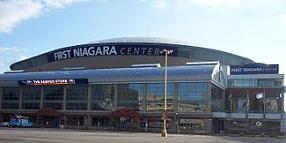
On Sept. 21, 1996 the $127.5M First Niagara Center (originally the HSBC Arena and the Marine Midland Arena) in Buffalo, N.Y. opens as the home of the NHL Buffalo Sabres.

On May 31-June 7, 1997 the 1997 Stanley Cup Finals see the Detroit Red Wings defeat the Philadelphia Flyers 4-0, becoming their 8th win, and first since 1955, also becoming the last team to win without having home ice advantage and with less than 100 points earned during the regular season until 2009; MVP is Wings goaltender (#29) Michael "Mike" Vernon (1963-).
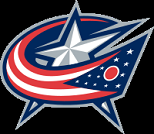
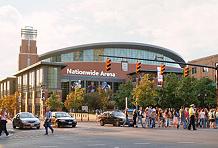
On June 25, 1997 the Columbus Blue Jackets NHL team is founded in Columbus, Ohio, playing their home games at $175M Nationwide Arena (opened Sept. 9, 2000); on On Oct. 7, 2000 they play their first game as an NHL expansion team, becoming the city's first major league franchise since 1938 (the Columbus Athletic Supply of the Nat. Basketball League, later NBA).
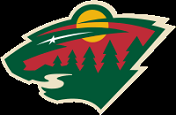
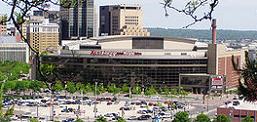
On June 25, 1997 the Minnesota Wild NHL team in St. Paul, Minn. is founded, playing their home games at the $170M Excel Energy Center AKA The X (opened Sept. 29, 2000).


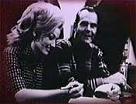
On June 25, 1997 after the New Jersey Devils turn down a $20M relocation bonus, the Nashville Predators NHL team is founded in Nashville, Tenn., playing their home games at the new $144M Bridgestone Arena (opened Dec. 18, 1996); in 1999 it becomes the Gaylord Entertainment Center; in 2007 it becomes the Sommet Center; in 2010 it becomes the Bridgestone Arena; on Sept. 25 they adopt a saber-toothed cat (Smilodon) logo after the first skeleton E of the Mississippi River was discovered in 1971 during the construction of the First Am. Nat. Bank in downtown Nashville, Tenn. by Willow Springs, Mo.-born anthropologist Robert Bruce "Bob" Ferguson Sr. (1927-2001), Nashville record exec and composer of the song "On the Wings of a Dove".

On Dec. 2, 1997 the $260M Verizon Center in Washington, D.C. (cap. 20K) opens as the new home of the NHL Washington Capitals, NBA Washington Wizards, the WNBA Washington Mystics, and the Georgetown U. men's basketball team.
In 1997 the Internat. Ice Hockey Federation (IIHF) Hall of Fame is established in the Hockey Hall of Fame in Toronto, Ont., Canada, with the first crop of 30 (mainly from outside North Am.) inducted at the world championships in Helsinki, Finland; the Paul Loicq Award is established to a person who has made "outstanding contributions to the IIHF and international ice hockey".
On Jan. 9, 1998 The Hockey News selects Wayne Gretzky as the best NHL player of all time.
On Feb. 7-22, 1998 the XVIII Winter (18th) Olympic Games in Nagano, Japan feature 2,176 athletes from 72 nations participating in seven sports and 68 events in 15 venues, getting the lowest TV ratings in 30 years since Grenoble (X); the debut of women's ice hockey, curling, and snowboarding (invented in the 1960s); NHL players are allowed to participate in men's ice hockey; the opening ceremonies are attended by the Japanese Yamato emperor and empress; Germany wins 29 medals (2 gold), Norway 25 (10 gold), Russia 18 (9 gold), Canada 15 (6 gold), and Japan 10 medals (5 gold); the new "clap skate" (blade not attached to skater's heel) helps spur a slew of new speedskating records; on Feb. 17 the U.S. women's hockey team wins the gold in the first women's ice hockey competition in Olympic history, finishing 6-0; the Czech. Repub. wins the men's hockey gold medal, with Russia winning silver and Finland bronze; Tara Lipinski (1982-) of the U.S. upsets Michelle Kwan (1980-) of the U.S. in women's figure skating, becoming the youngest figure skater to win gold.
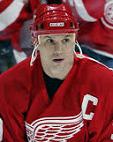
On June 9-16, 1998 the 1998 Stanley Cup Finals see the Detroit Red Wings defeat the Washington Capitols (first appearance) by 4-0, becoming their 9th win, the last sweep until ?, and the last 2-peat (until ?); MVP is 5'11" Wings center (team captain since 1986) Stephen Gregory "Steve" Yzerman (1965-).

On Feb. 2, 1999 the $265M Air Canada Centre in Toronto, Ont., Canada (begun Mar. 2, 1997) opens as the home of the Toronto Maple Leafs, hosting their 639th game with their arch-rival Montreal Canadiens.


On June 8-19, 1999 the 1999 Stanley Cup Finals see the Dallas Stars (first appearance since their 1993 move from Minn.) defeat the Buffalo Sabres 4-2 after Stars right wing Brett Andrew Hull (1964-) (son of Bobby Hull) scores the winning goal in triple OT with his foot in the crease but the puck not, causing a firestorm of controversy, with Sabres fans calling it the "No Goal" game; MVP is 6'2" Stars center Joseph "Joe" Nieuwendyk (1966-).
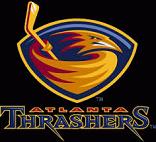
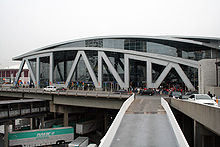
On Oct. 9, 1999 the NHL Atlanta Thrashers (founded June 25, 1997) play their first regular season game, going on to play their home games at the new $213.5M Philips Arena (opened Sept. 18, 1999); after being eliminated in round 1 of the 2007 playoffs by the New York Rangers they move in 2011 to Winnipeg, Man., becoming the new Winnipeg Jets - for a team based in hot steamy Atlanta to win the Stanley Cup, Hell would have to freeze over?
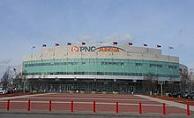
On Oct. 29, 1999 the $158M Raleigh Entertainment and Sports Arena (ESA) in Raleigh, N.C. opens as the home of the NHL Carolina Hurricanes, becoming the Royal Bank of Canada Arena in 2002, and the PNC Financial Services Arena in 2011.
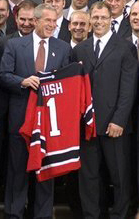
On May 30-June 10, 2000 the 2000 Stanley Cup Finals see the New Jersey Devils defeat the Dallas Stars 4-2 in double OT; MVP is Devils defenceman Ronald Scott Stevens (1964-); after the 1999-2000 season the Roger Crozier Saving Grace Award, named for goalie (1960-77) Roger Allan Crozier (1942-96) is established by the NHL for the goaltender with the best save percentage during the regular season after playing 25+ games; the first award goes to Ed Belfour of the Dallas Stars; the last award (2006-7 season) goes to Niklas Backstrom of the Minnesota Wild.

On May 26-June 9, 2001 the 2001 Stanley Cup Finals sees the Colorado Avalanche defeat the New Jersey Devils 4-3, becoming their 2nd win; the first Finals since 1989 where #1 seeds meet; former Boston Bruins star (#77) (1979-2000) Raymond Jean "Ray" Bourque (1960-) of the Avalanche wins his only Stanley Cup in his final NHL game; MVP is Avalanche goalie Patrick Roy.





On Feb. 8-24, 2002 the XIX (19th) Winter Olympic Games are held in Salt Lake City, Utah, with 2,399 athletes (1,513 men, 886 women) from 78 nations competing in 78 events in seven sports; the U.S. wins a record 34 medals, and Germany a record 35; Canada, led by half-white half-black Jarome Athur-Leigh Adekunle Tig Junior Elvis Iginla (Yoruba "big tree") (1977-) wins the men's hockey gold medal, followed by the U.S., Russia and Sweden (tie); Iginla joins the Dallas Stars in 1995, becoming capt. of the Calgary Flames, setting a team record for goals, points, and games played, scoring 50 goals in two separate seasons, and 30 goals in 11 straight seasons; on Feb. 19 Ala.-born U.S. bobsledder Vonetta Flowers (1973-) becomes the first black athlete to win a gold medal at a Winter Olympic Games; Seattle-born short-track speedskater Apolo Anton Ohno (1982-) wins gold in the 1.5Km when judges disqualify South Korean Dong-Sung Kim; America's most popular figure skater Michelle Kwan (1980-) ends up with a silver behind surprise winner Sarah Elizabeth Hughes (1985-) of the U.S. - first Tara, then Sarah?

On June 4-13, 2002 the 2002 Stanley Cup Finals see the Detroit Red Wings defeat the Carolina Hurricanes 4-1; MVP is 6'1" Swedish-born defenceman Erik Nicklas Lidström (1970-), becoming the first European player named playoffs MVP.

On May 27-June 9, 2003 2003 Stanley Cup Finals see the New Jersey Devils defeat the Anaheim Mighty Ducks (first appearance in the Finals) 4-3, ending the Devils-Avalanche-Red Wings string of titles since 1995; MVP is 6'1" Ducks goaltender Jean-Sebastien Giguere (Jean-Sébastien Giguère) (1977-).
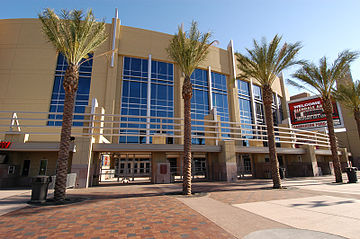
On Dec. 26, 2003 the $220M Glendale Arena in Glendale, Ariz. across the street from the U. of Phoenix Stadium opens as the home of the NHL Arizona Coyotes and NLL Arizona Sting; in Oct. 2006 it becomes Jobing.com Stadium; in Aug. 2014 it becomes Gila River Arena.

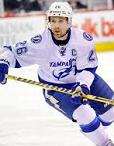
On May 25-June 7, 2004 the 2004 Stanley Cup Finals see the Tampa Bay Lightning (first appearance in the Finals) defeat the Calgary Flames (first appearance since 1989) 4-3; MVP is 6'0" center Bradley Glenn "Brad" Richards (1980-) of the Lightning; on June 5 in Game 6 a goal by Lightning right wing Martin St. Louis (1975-) 33 sec. into the 2nd OT forces a game 7; on June 15 the Detroit Pistons defeat the Los Angeles Lakers 4-1 to win the NBA title, making owner William Davidson the first pro sports owner to win two titles in one year.
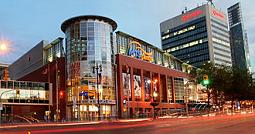
On Nov. 16, 2004 the $133M MTS Centre in Winnipeg, Man. opens as the home of the NHL Winnipeg Jets and the AHL Manitoba Moose; on Oct. 17, 2011 the Winnipeg Jets win their first game there.

On Feb. 16, 2005 NHL commissioner (since 1993) Gary Bruce Bettman announces that the league's entire season is being cancelled because of a labor dispute over a salary cap, becoming known as the 2004-5 NHL Lockout; the NHL becomes the first prof. league in North Am. to shut itself down; on July 22 NHL commissioner Gary Bettman announces the end of the 310-day lockout and unveils rule changes to favor more offense.
On May 15, 2005 the Czech Repub. beats Canada for a 3rd straight time in the world ice hockey championships in Vienna Austria, winning 3-0.

On June 5-19, 2006 the 2006 Stanley Cup Finals see the Carolina Hurricanes defeat the Edmonton Oilers 4-3; MVP is 6'2" Hurricanes goalie Cameron Kenneth "Cam" Ward (1984-), becoming the first starting goaltender to win since Patrick Roy in 1986.
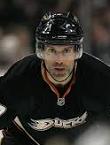
On May 28-June 6, 2007 the 2007 Stanley Cup Finals see the Anaheim Ducks defeat the Ottawa Senators 4-1, becoming their first win, the first West Coast team since the 1925 Victoria Cougars, and the 3rd consecutive first-time winner after the Carolina Hurricanes and Tampa Bay Lightning; MVP is 6'1" Ducks defenceman (team capt.) Scott Niedermayer (1973-).

On Oct. 25, 2007 the $375M Prudential Center in Newark, N.J. opens as the home of the NHL New Jersey Devils, the NBA New Jersey Nets, and the NCAA basketball Seton Hall Pirates.
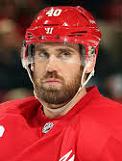
On May 24-June 4, 2008 the 2008 Stanley Cup Finals see the Detroit Red Wings defeat the Pittsburgh Penguins 4-2, becoming their 11th win and 4th in 11 seasons; MVP is Swedish-born 5'11" center Henrik Zetterberg (1980-), who scores the series-winning goal; Niklas Lidstrom becomes the first Euro-born-and-trained team capt. to win the Stanley cup.

On May 30-June 12, 2009 the 2009 Stanley Cup Finals see the Pittsburgh Penguins defeat the Detroit Red Wings 4-3, making Pittsburgh the only city to win the Super Bowl and Stanley Cup in the same year; Pittsburgh becomes the 2nd team after the 1971 Montreal Canadiens to win after losing the first two games on the road; MVP is 6'3" Penguins center Evgeni (Yevgeni) Vladimirovich "Geno" Malkin (1986-), who becomes the first Russian-born and Asian-born MVP.
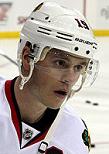
On May 29-June 9, 2010 the 2010 Stanley Cup Finals see the Chicago Blackhawks defeat the Philadelphia Players 4-2, becoming their 4th title and first since 1961; MVP is 6'2" Blackhawks center Jonathan Bryan Toews (1988-), who passes Peter Forsberg to becoming the youngest player to join the Triple Gold Club.

On June 1-15, 2011 the 2011 Stanley Cup Finals see the Boston Bruins defeat the Vancouver Canucks 4-3, becoming their first since 1972); MVP is Bruins goalie Timothy James "Tim" Thomas Jr. (1974-) (oldest and 2nd Am.-born player to win), who snubs a White House appearance on Jan. 23 because of political differences with Pres. Obama.
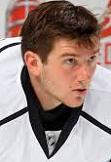
On May 30-June 11, 2012 the 2012 Stanley Cup Finals see the Los Angeles Kings defeat the New Jersey Devils 4-2 to win their first title, becoming the 2nd time since 1996 in which no Canadian teams advance past the first round; MVP is 6'1 Kings goalie Jonathan Douglas Quick (1986-).
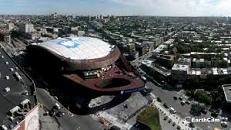
On Sept. 21, 2012 $1B Barclays Center multipurpose indoor arena in Brooklyn, N.Y. opens as the home of the NBA Brooklyn Nets and NHL New York Islanders.
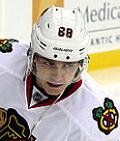
On June 12-24, 2013 after a lockout causes the season to be shortened to 48 games, the 2013 Stanley Cup Finals see the Chicago Blackhawks defeat the Boston Bruins 4-2 to win their 2nd NHL title in four years; MVP is 5'10-" Blackhawks right winger Patrick Timothy Kane II (1988-).

On June 4-13, 2014 the 2014 Stanley Cup Finals see the Los Angeles Kings defeat the New York Rangers 4-1, becoming their 2nd win, and 2nd in three seasons; the first meeting between major prof. sports teams from New York City and Los Angeles for a championship since the Yankees and Dodgers in the 1981 WS, during which post-season the Rangers eliminated the Kings during a preliminary round; MVP is 6'1" Kings right wing Justin Williams (1981-), known as Mr. Game Seven for the most Game 7 points in NHL playoff history, who on July 1, 2015 signs with the Washington Capitals.
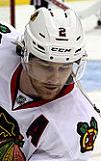
On June 3-15, 2015 the 2015 Stanley Cup Finals see the Chicago Blackhawks defeat the Tampa Bay Lightning (2nd appearance) 4-2, becoming their 6th title and 3rd in six seasons; Tyler Johnson and Patrick Kane each score 23 points; MVP is 6'1" Blackhawks defenceman Duncan Keith (1983-).
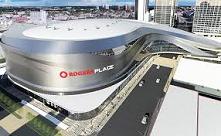
On Sept. 10, 2016 Rogers Place in Edmonton, Alberta, Canada (cap. 18.6K) opens as the home of the NHL Edmonton Oilers.
On May 29-June 7, 2017 the 2017 Stanley Cup Finals see the Pittsburgh Penguins defeat the Nashville Predators 4-2; Penguins captain Sidney Crosby is MVP.
On May 28-June 7, 2018 the 2018 Stanley Cup Finals sees the Washington Capitals (2nd appearance) defeat the Vegas Golden Knights (1st appearance) 4-1; MVP is Washington captain Alexander Ovechkin.
On Feb. 22, 2020 after the regular goalies are injured, 42-y.-o. Zamboni driver and emergency backup goalie David Ayres (1977-) becomes the oldest goalie to win an NHL debut as the Carolina Hurricanes defeat the Toronto Maple Leafs 6-3.